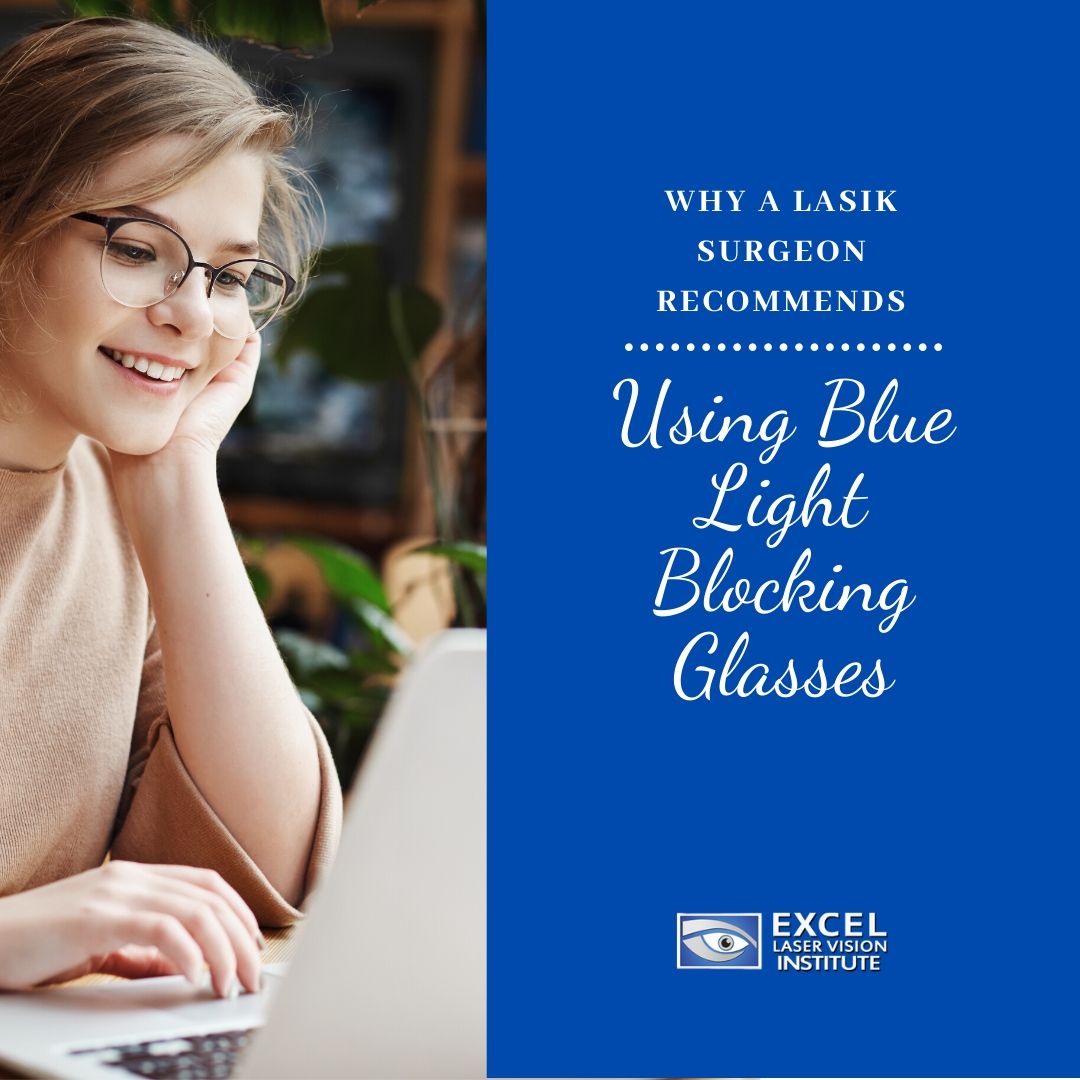
Why Use Blue Light Blocking Glasses?
For many people living in the 21st century, screen time makes up most of the day, from work computers to TVs at home and smartphone interactions in between. Most of us cannot seem to get a break from these screens because they are a daily source of information, communication, and entertainment. If you speak to a LASIK surgeon in Orange County about the effect of screen time on our eyes, they will probably mention blue light. While blue light is not exclusively emitted from our digital screens, it is certainly one of the most disruptive factors that 24/7 screen time can have on a person.

Fortunately, there is an easy solution. Stylish blue light blocking glasses have been on the market for quite some time. They are non-prescription glasses that have been created to minimize the effect of screen time on our bodies and minds. According to an Orange County LASIK surgeon, Doctor Moosa, these glasses have been known to help eliminate blue-light-related headaches and help others sleep better. While not everyone has heard of these glasses, they are widely available for purchase and budget-friendly.
The Vision Council of America says that about 70 percent of adults in the United States experience eye strain as a result of digital devices. So, what exactly is blue light and how does it affect us?
Blue light can come from computers, tablets, phones, LED lights, fluorescent lights, and sunlight. It is one of the colors on the light spectrum that people can see with their naked eye. In small doses, it is not necessarily a bad thing. LASIK Orange County eye specialists say that blue light can help us stay alert and energized during the day. However, the problem occurs when we are constantly exposed to the light. Instead of regulating our sleep/wake cycles, blue light can disrupt them when we refuse to limit our exposure at night. The American Macular Degeneration Foundation has also linked blue light exposure to retinal damage and increased risk of age-related vision loss.
Since blue light blocking glasses were invented, they have slowly gained attention for their ability to filter out harmful light rays as people go about our daily lives. Plus, there are quite a few unique and trendy designs that make them a great accessory to any look. Back in the day, your parents or grandparents might have owned a pair BluBlockers, which were created in 1986 for astronauts and quickly became available to the public as well. New studies on blue spectrum light waves and their effect on vision clarity and comfort made these glasses a reality.
Now, Americans spend around half of their lives looking at screens. According to an article by the New York Post, our obsession with digital devices has disrupted our sleep cycles, given us more headaches, strained our eyes, and increased our chances of getting cataracts. This negative correlation between our health and our interaction with digital devices has caused many people to stop and consider how they can reverse this trend.
Blue light blocking glasses have actually become a great resource for parents. Now that younger children are being exposed to more screen time than their parents were at their age, it is important to think about the effect of blue light on developing eyes. Since children naturally have larger pupils, they are much more sensitive to the light rays. This means that they can also suffer headaches, eye strain, and restless sleep with too much exposure.
In addition to buying blue light blocking glasses, parents can adjust their children to less screen time by setting rules for how long they can use their tablet, phone, or watch the TV. When you are browsing for children’s glasses, you will want to get a nice case to keep them protected when they are not in use. Once kids become used to putting on their blue light blocking glasses everytime they sit down in front of a screen, they will likely continue these healthy habits into adulthood.
For adults that are interested in blue light blocking glasses but also rely on eyeglasses or contacts to see, they may consider getting LASIK surgery in Orange County in order to be free of their prescription lenses. According to an Orange County LASIK surgeon, Doctor Ferzaad Moosa, many people feel their quality of life is greatly improved after their vision correction procedure. Not only is it convenient to no longer be dependent on glasses or contacts, but it also often helps people achieve better vision than they thought possible for themselves. The clarity of vision and saturation of color that people experience after the LASIK surgery is life-changing.
So, once you have finally achieved clear vision through LASIK, you can replace your prescription lenses with protective blue light blocking glasses and keep your eyes healthy and happy. Here is a list of the advantages you gain from wearing blue light blocking glasses:
- Less strain on your eyes. If you work for an office, then you might understand the eye strain and fatigue that one can experience when staring at the computer all day. Blue light blocking glasses will alleviate those uncomfortable symptoms and leave you feeling more like yourself.
- Better sleep. When you’re scrolling through social media or watching Netflix before bed, you may feel like you are relaxed but the blue light emitted from your screen is actually making you more awake. The light rays are a high frequency which can make it harder for you to fall asleep and stay asleep. With blue light blocking glasses, you can still sit down to your nightly entertainment without compromising your sleep cycle.
- Decreasing your risk of getting cancer. Some studies have shown a connection between blue light exposure and cancer. This research has focused on the ability of blue wavelengths to slow the production of melatonin. Blue light blocking glasses can help restore this natural melatonin production that your body needs.
- Prevent age-related vision loss (macular degeneration). About 11 million people in the U.S. suffer from macular degeneration, which is when the center of the retina deteriorates and eventually causes blindness. With blue light blocking glasses, people can protect their retinas from being damaged by blue light and help prevent macular degeneration.
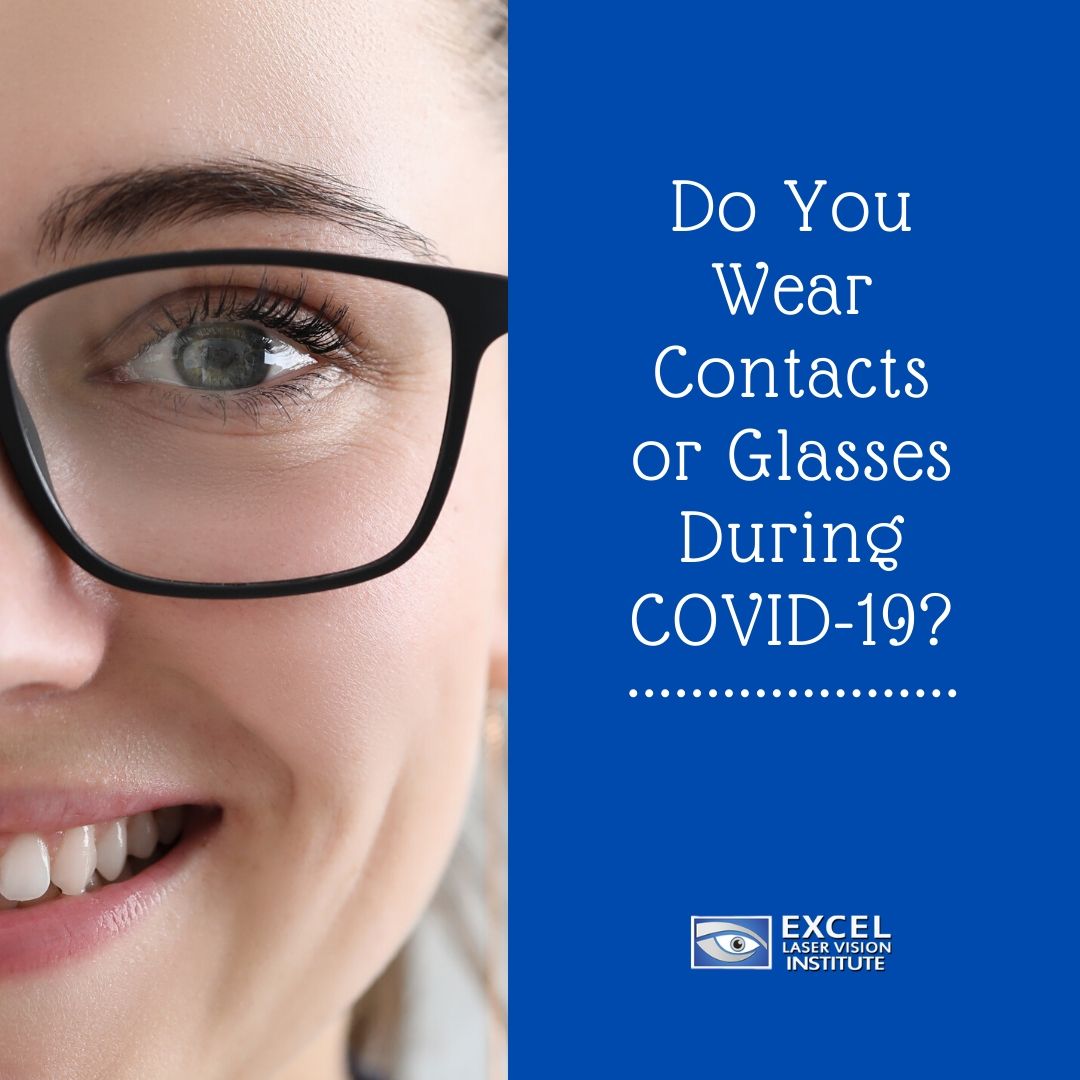
Eye Care During COVID-19: Contacts or Glasses?
Nowadays, people are becoming more aware of their hygiene practices and the habits that increase their risk of infection. At the start of the coronavirus outbreak, doctors were telling everyone to limit touching their mouth, nose, and eyes as well as washing hands frequently. Many people with prescription glasses or contacts began to understand the extent of their dependency on prescription lenses, and how LASIK would significantly improve their lives in times like these. Unfortunately, many of those people will have to wait to schedule an appointment with a LASIK surgeon like Doctor Moosa. With many offices closed for non-urgent appointments, people in Orange County are having to adjust to certain eye safety practices and routines.
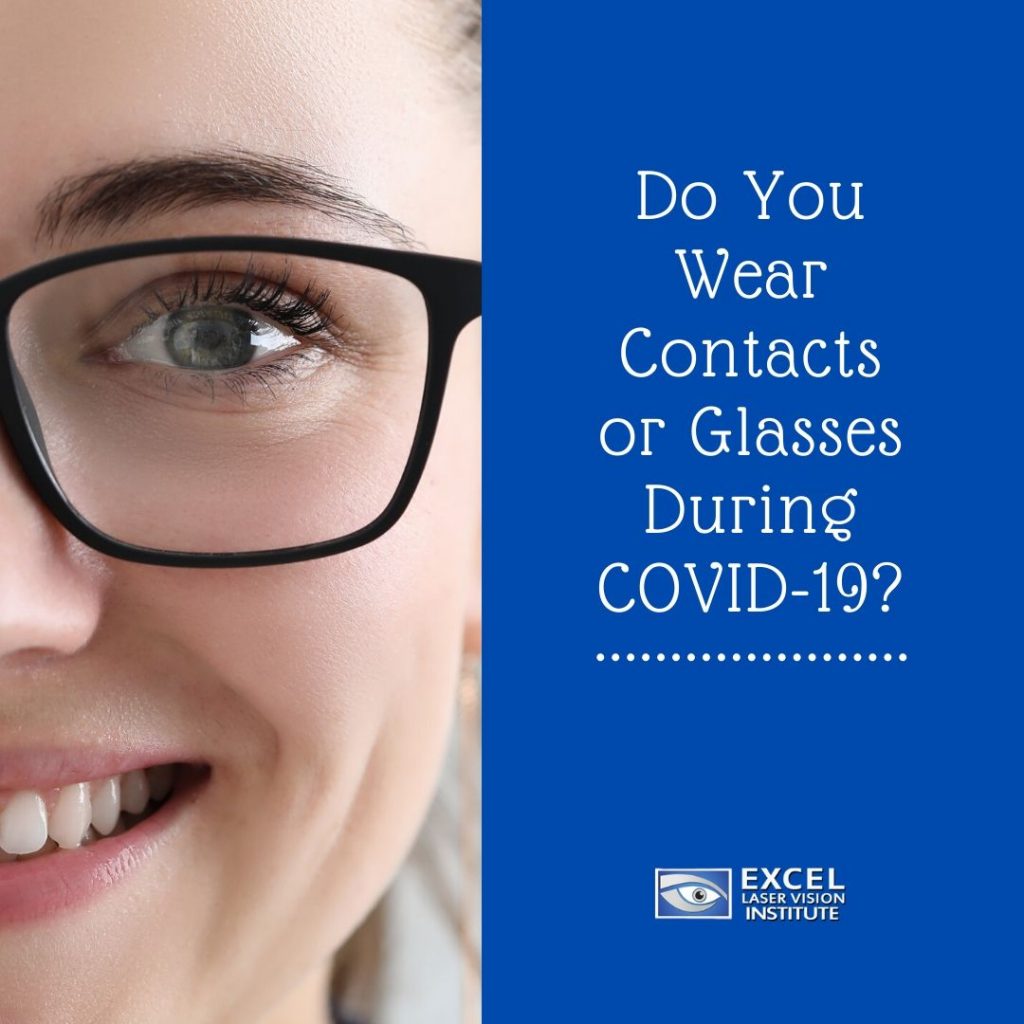
The contacts versus glasses debate began when some eye doctors began to caution patients against wearing their contact lenses in order to avoid contamination of the mucous membrane through finger-eye contact. LASIK clinics in Orange County like Excel Laser Vision Institute agreed that glasses were a safer option. However, both require increased awareness in times like these because people that wear contacts or glasses touch their faces more often than those who do not.
While wearing glasses does not guarantee that you will not get sick, it can certainly help protect against the habit of touching your eyes. The Orange County LASIK surgeon says that glasses can also act as a partial shield from infected droplets that travel through someone else’s cough or sneeze.
For many reasons, glasses have been the standard recommendation in times when infection rates are being closely monitored. However, there are some cases in which contacts can be utilized in a safe and effective manner, especially for those who have limited options. According to a LASIK surgeon in Orange County, Doctor Moosa, you need to abide by certain safety standards when continuing to wear contact lenses. For one, not wearing them when you are feeling sick. Even if it is just a cold, you don’t want to risk transferring infections to your eye. Another rule to live by in times like these is to use disposable lenses.
Contacts are necessary and comfortable for many people, which is why there has been so much pushback against the suggestion to wear glasses. Ultimately, it comes down to your own personal situation. According to research by the American Academy of Ophthalmology, the ocular transmission of the coronavirus is not yet a widely supported fact. However, the eyes contain sensitive mucous membranes, just like the mouth and nose, which is why doctors are advising caution all the same. For many people, the risk is not worth the convenience of wearing their contact lenses.
Whichever form of vision correction you choose, it is important to regularly disinfect your lenses and wash your hands whenever interacting with your face. Here are some more eye safety tips from one of the Orange County LASIK surgeon– Doctor Ferzaad Moosa.
Tips for Those Who Wear Contacts
Before you touch your contact lenses, wash your hands with soap and water for up to 20 seconds. You can use a lint-free towel to dry them. Repeat this routine every time you need to remove, insert, or adjust your lenses. When you don’t have access to a sink, you may use hand sanitizer with 60% alcohol.
If you are using disposable lenses, then you should throw them out after every day. If you are using monthly or bi-weekly lenses, then you need to follow disinfection guidelines by your eye doctor or the manufacturer. Saline solution or rewetting drops are not acceptable methods of disinfecting.
If you start feeling sick, you should immediately stop wearing your contacts.
Tips for Those Who Wear Glasses
According to recent studies, the coronavirus can remain on certain surfaces for up to a few days. It is possible to transfer infected droplets to your glasses when putting on, adjusting, or removing them. In order to accommodate these risks, it is important to frequently clean your glasses.
Those who regularly wear face masks and glasses have also experienced the fogging-up effect that can severely block your vision. In order to prevent this inconvenience, while still wearing your protective mask, there are a few different measures you can take:
- Seal the mask. The reason that your glasses are fogging up is because your breath is escaping from the top and sides of the mask. Good quality medical masks (N95) usually do not have this problem because they have a tight seal to keep the air in. So, when you are using your handmade cloth mask, you can mimic this seal by attaching a bendable strip like a twist-tie, paperclip, or pipe cleaner to the top. This can form around your nose and cheeks in order to create a tighter seal. You can also use some kind of skin-sensitive adhesive like cloth tape.
- Wear your glasses differently. For some people, it helps to move glasses father down from the bridge of the nose, on top of the mask. This is especially helpful in situations where you cannot make the mask fit tighter. You can also try the reverse, which is pulling the mask up higher so that it rests under the bridge of your glasses. It may not be the best look, but it should certainly decrease the amount of moisture traveling up to your lenses. Just make sure that when you are adjusting things your mask is still effectively covering your mouth and nose. After all, the most important thing is that you are protected from potential infection.
- Wash your lenses. You can buy an anti-fog coating for your glasses. These products are sold as wipes or sprays. However, there is also a more cost-effective method which is soap and water. Many people have found that washing their glasses with soap and water and then letting them dry is an effective way of preventing fogging. The soapy residue leaves a thin film on the glass which can help block moisture. Follow these washing instructions for fog-free glasses.
- Notice your breathing. Doctors that are used to the inconvenience of fogged-up glasses from wearing masks say that breathing through your nose helps. It also helps if your head is tilted up instead of down. It may take some getting used to, but everyone will start to figure out their technique for reducing the amount of fog in their glasses.
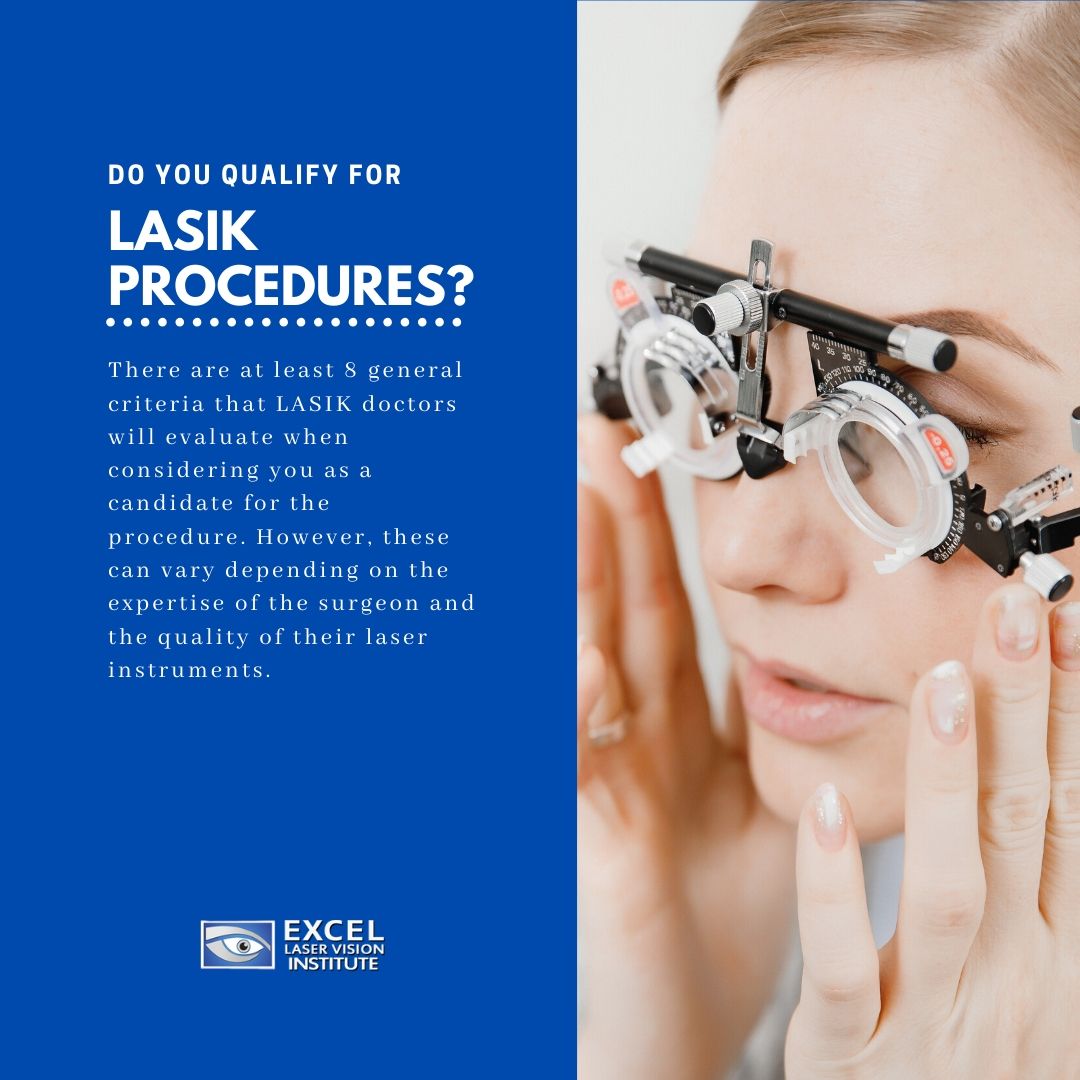
Do You Qualify for LASIK Procedures?
LASIK eye surgery has become extremely popular and widespread over the last few decades, which has prompted many people to wonder if they themselves qualify for the procedure. At LASIK clinics in Los Angeles like Excel Laser Vision Institute, doctors are highly selective when it comes to picking candidates for the surgery. Everything is tested, confirmed, and optimized to make the process safe and effective each time.
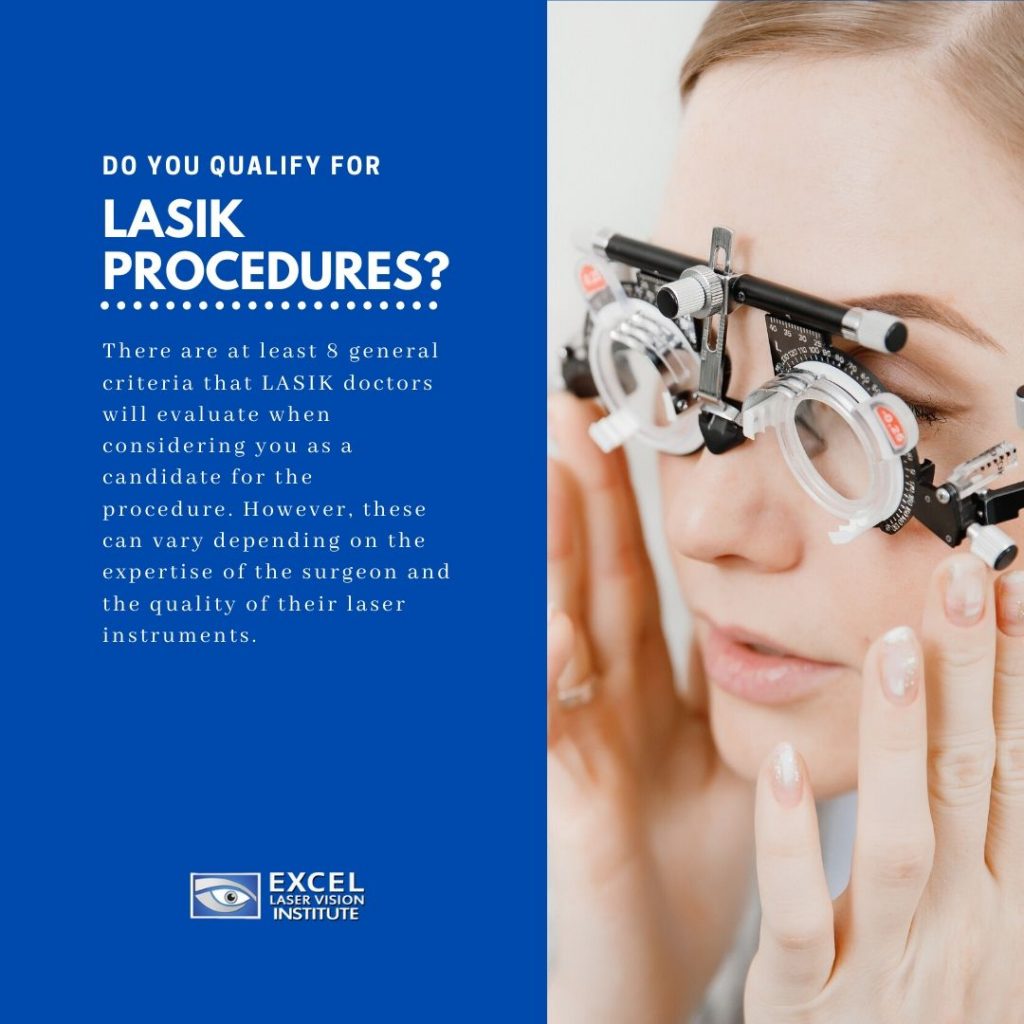
So, how do you know if you are eligible for laser eye surgery clinics such as Excel Laser Vision Institute? There are a few different factors. Once you have been tested to determine your eye health and prescription, your LASIK eye specialist in Loss Angeles will consult you about your eye care history and vision goals.
There are at least 8 general criteria that LASIK doctors will evaluate when considering you as a candidate for the procedure. However, these can vary depending on the expertise of the surgeon and the quality of their laser instruments. In order to fully determine if you are qualified for LASIK, you should schedule an eye examination and consultation at a LASIK eye center in Los Angeles like Excel Laser Vision Institute. In the meantime, though, you can read through our list and see how well your situation matches up with the qualities that LASIK eye surgeons are looking for.
Eye Health
When a LASIK Los Angeles eye specialist gives you an eye examination, they are looking at different aspects of your eye health that might be impacted by the surgery. Pre-existing eye conditions may or may not affect how well your eyes heal or how they will take to laser technology.
Temporary eye conditions like pink eye, dry eye, infections, or eye injuries can complicate the surgery. Thus, LASIK doctors in Los Angeles like Doctor Moosa will usually recommend that patients come back for LASIK after their eyes have fully healed from their previous condition.
It is always best to speak to a doctor about your past and current eye conditions so that you can eliminate any risk of complications when you are preparing for LASIK eye surgery. Some people have an extreme case of dry eye, which means that they do not produce enough moisture in their eyes to keep them lubricated, causing a burning or stinging sensation. People with this kind of condition may be more sensitive to LASIK and, thus, will require special attention or a vision correction alternative.
Cornea Size
When you are being evaluated for LASIK eye surgery, your eye examiner will check to see if your cornea is an appropriate size and shape for the procedure. This will determine if you are eligible for LASIK or more suited to an alternative like PRK. If you have a thinner cornea or it is an irregular shape, this could disqualify you for certain types of laser vision correction surgery. However, don’t be discouraged! Advances in laser technology have already made vision correction possible for people with many different eye conditions.
If you have not qualified for LASIK in the past, you may consider going into a LASIK clinic for a second opinion. Not only has technology improved, but certain clinics have better access to equipment and, thus, can successfully perform LASIK under more complicated circumstances. Even if you still cannot undergo the surgery, there may be vision correction alternatives that were made to accommodate your kind of eye condition and may even be better suited to your lifestyle. Consult an eye specialist to determine your best course of action to reach your vision goals.
Pupil Size
LASIK eye examiners will also check your pupil size. People with larger-sized pupils can sometimes experience halos, glares, and starbursts after their LASIK eye surgery. Therefore, LASIK eye surgeons will use a particular scale to determine whether your pupils fall within a safe range.
Prescription
Another important thing that doctors check when considering you as a candidate for LASIK is your prescription. Higher prescriptions were disqualified in the past because technology was not advanced enough to accommodate these eye conditions. However, the range of prescriptions that can be satisfied with LASIK surgery has significantly increased. Nowadays, doctors will utilize your prescription to recommend the best version of laser vision correction. Whether you have astigmatism, myopia, or hyperopia, your LASIK eye specialist will help you determine the best course of action to achieve your vision goals.
Age
Age will affect prescription, which is why LASIK doctors generally like to pay attention to this factor. For some younger people, eye prescriptions may not be stable enough to warrant the surgery. Generally, LASIK surgeons pick candidates who have maintained the same refractive errors with no variation for up to 12 months. Most LASIK procedures require you to be 18 or older; although, there are some exceptions.
For patients over 40, LASIK is still a viable solution for vision correction. However, it may not fix all vision problems. Some LASIK patients over 40 will still require reading glasses for their presbyopia. In other cases, eye specialists will recommend a monovision LASIK procedure or other options to fully target vision issues.
Both women and men are susceptible to dry eye conditions later in life, which must be considered by the eye surgeon before LASIK is performed.
General Health
While LASIK is mostly concerned with eye health, a person’s general health is still a big factor in determining the safety and effectiveness of the procedure. Certain autoimmune diseases or degenerative conditions will disqualify a candidate for the elective surgery. However, it all depends on the patient’s condition and the doctor’s experience in similar cases.
LASIK surgeons will also consider the types of medications that patients take on a daily basis. Some prescription drugs can have a negative effect on post-operative recovery or increase symptoms like dry eye.
Pregnancy
Most LASIK surgeons will advise pregnant or nursing women to wait until their hormonal cycles have regulated before they come in for the surgery. Hormones can affect eye conditions like the size and shape of the cornea or dry eye symptoms.
Generally, the medications before and after LASIK surgery are also not recommended for pregnant or nursing women, which is why it is best to wait a few months before having the procedure performed.
Vision Goals
Lastly, your doctor will want to talk to you about your expectations for LASIK and ensure that you are satisfied in your choice of corrective eye surgery. For your lifestyle and prescription, LASIK may or may not be the right option. However, there are an array of refractive surgery alternatives that can serve to help you achieve your vision goals.
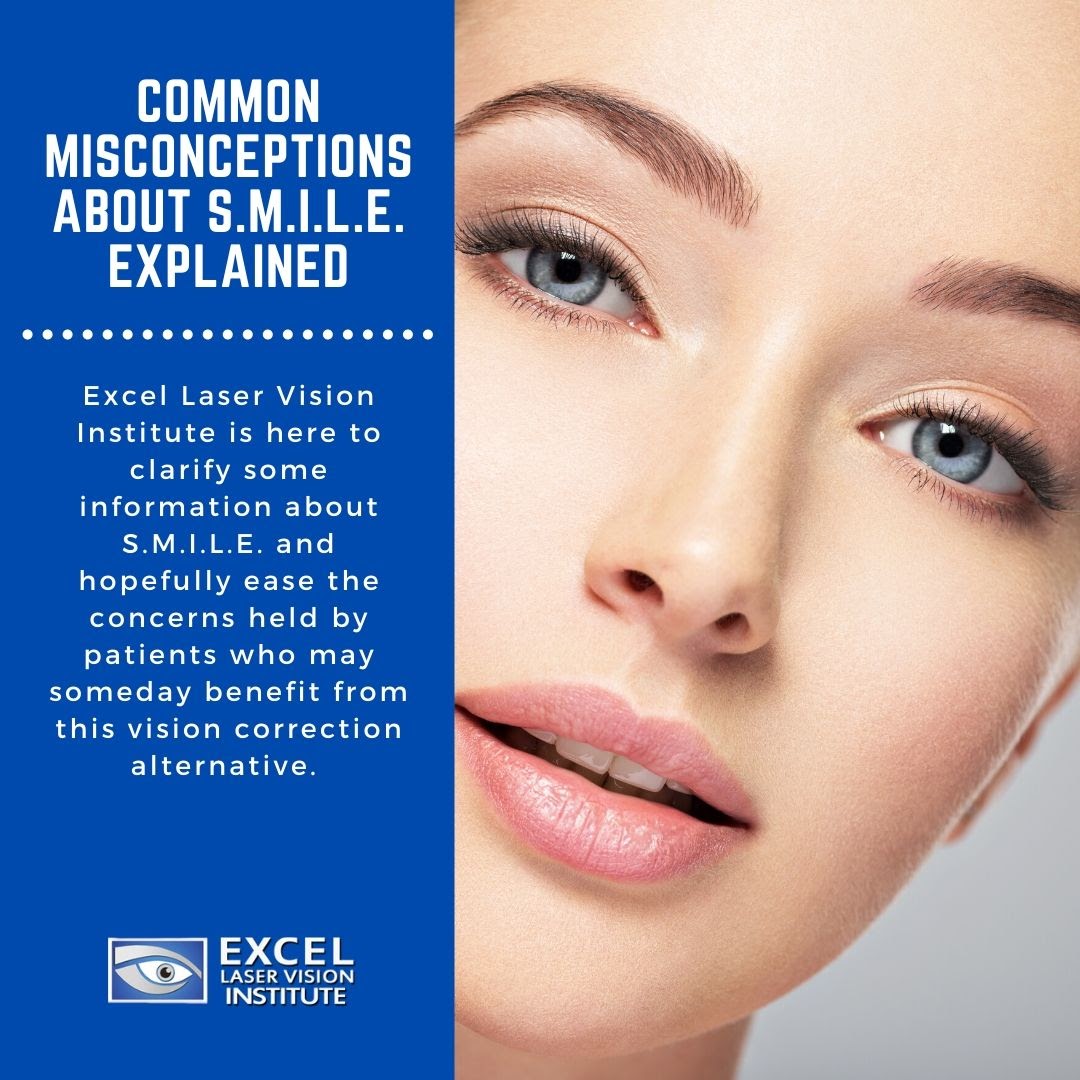
Common Misconceptions About S.M.I.L.E.
Many people are sensitive when it comes to talking about eye surgery procedures. It can be uncomfortable for some to imagine a LASIK surgeon in Orange County fixing a very delicate, very important body part that they use on a daily basis. However, this general silence on the topic has allowed for widespread misconceptions to take over the conversation.

As one of the newest innovations in laser eye surgery, S.M.I.L.E. has come under the scrutiny of audiences. Many people have an incomplete understanding of the process and, thus, are hesitant to accept it as a valuable treatment option. The LASIK Orange County surgeon is here to clarify some information about S.M.I.L.E. and hopefully ease the concerns held by patients who may someday benefit from this vision correction alternative.
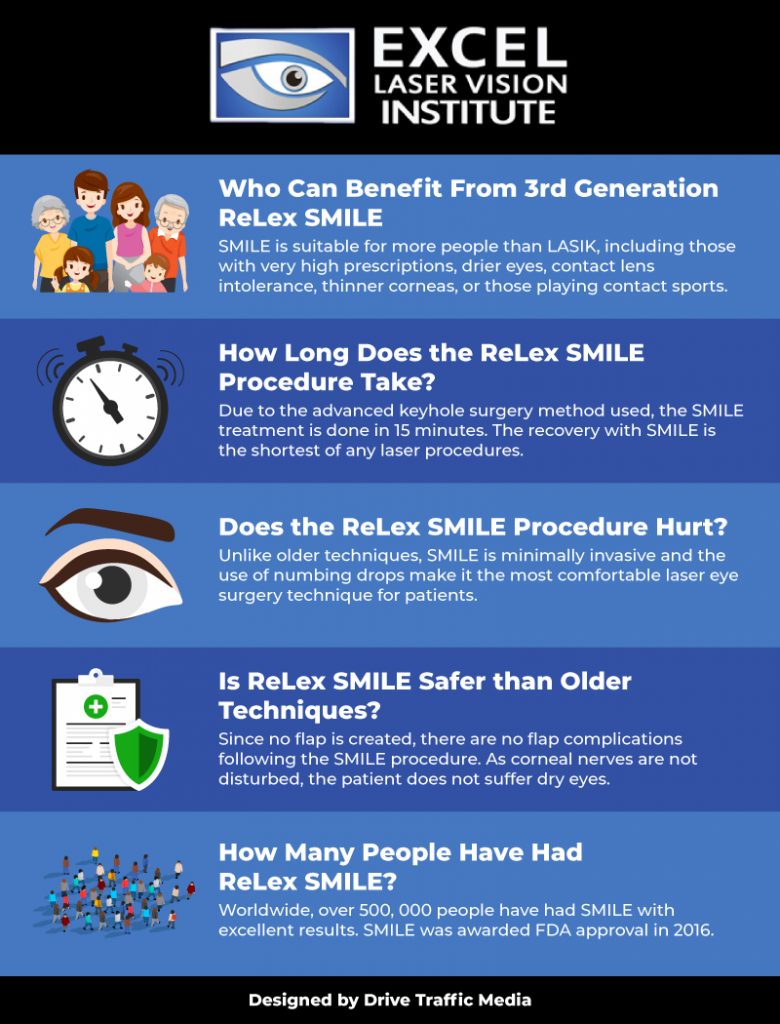
S.M.I.L.E. is not an established and trustworthy procedure because it is so new.
Compared to procedures like LASIK or PRK, S.M.I.L.E. is certainly a new addition to the laser eye surgery world. However, it is not true that this method is unreliable, unsafe, or inaccurate. In fact, years of research have gone into studying S.M.I.L.E. as a method of correcting vision. Clinics are offering S.M.I.L.E. now because it has been proven as a successful and safe practice to help nearsighted patients. If you ask a LASIK surgeon in Orange County about S.M.I.L.E., they will tell you that the FDA has already approved the procedure and that many professionals in the field have been utilizing it on a widespread basis for quite a while.
Innovation in laser eye surgery will continue to develop and expand as the years go by. However, that does not mean that people should not trust the current available technology. S.M.I.L.E. has already succeeded in helping patients all over and has generated overall positive reviews.
After your S.M.I.L.E. surgery, you will still have to wear glasses.
This statement is not completely false. However, it comes from an incomplete understanding of the procedure. In a study conducted by the FDA, results found that 98.5 percent of patients experienced an outstanding improvement in vision while 93 percent of patients gained almost perfect vision.
The misconception that you will need glasses after getting S.M.I.L.E. comes from the statistic that follows. The FDA found that 2.5 percent of patients in their study noticed that their vision quality decreased after about a year. All other patients maintained the same quality of vision that they gained after the surgery or even experienced better vision.
So, while S.M.I.L.E. is not an absolute fix for vision problems, it is generally a helpful and accurate treatment option. At this point in time, there is no procedure that can permanently fight natural eye decay.
S.M.I.L.E. is a dangerous procedure that can cause blindness.
As with any surgery, S.M.I.L.E. cannot guarantee complete security from complications. However, the concern that a patient could go blind from a S.M.I.L.E. procedure is completely unfounded. S.M.I.L.E. has an outstanding track record for safety and accuracy with patients.
According to the FDA’s study, only 10.4 percent of patients noticed a glare in their vision after the surgery and a majority of those who experienced symptoms didn’t have them after a year’s time. In the case where vision abnormalities continue, a LASIK surgeon in Orange County may simply recommend a follow-up procedure to correct the annoyance.
As the newest innovation in laser eye surgery, S.M.I.L.E. is actually designed to lessen the risks involved with LASIK surgery. Since this procedure utilizes a tiny incision instead of a flap, it decreases the chances of causing dry eye or thinning out the cornea.
S.M.I.L.E. will hurt and complications could arise if the patient blinks.
Eye surgeons utilize numbing drops in a S.M.I.L.E. procedure to help relax the eye muscles and avoid any discomfort for the patient. The surgeon will also employ a suction and speculum instrument to hold still the eye that is being worked on. S.M.I.L.E. procedures only take about 15 minutes and most patients admit that it is a pain-free surgery.
Compared to other laser eye surgeries, S.M.I.L.E. provides a relatively smooth and quick recovery process as well. Some patients may experience mild symptoms in the beginning of their healing timeline; however, doctors will prescribe the necessary drops and advise the best routine to support a full recovery.
After your S.M.I.L.E. surgery, you will have a difficult time recovering.
Recovery may look different for individual people. However, most S.M.I.L.E. patients find the transition to be quite manageable. Usually, doctors will advise patients to stay inside and rest the day after the surgery. Then, most patients are able to get back to work almost immediately after. Some people will need an extra day or two depending on the intensity of their job or routine. However, the recovery process is often very smooth and convenient.
S.M.I.L.E. will not be able to fix my vision problems.
S.M.I.L.E. cannot fix all vision problems; however, it can fix a majority of nearsighted cases as well as astigmatism. While it is true that this method has not yet been verified for correcting farsighted cases, some surgeons in Europe are finding that it is effective in treating minor farsighted issues. It doesn’t hurt to ask a LASIK specialist about S.M.I.L.E. and, if your particular eye condition does not match up with the treatment, they will recommend another procedure.
S.M.I.L.E. is not a good long-term solution for my vision problems.
As was mentioned before, no laser eye surgery is completely permanent. Eye decay is a natural process that happens with age. However, this does not mean that S.M.I.L.E. is not a viable option with long-term results.
Even with regards to natural decay, S.M.I.L.E. procedures are designed to reshape the cornea which will last even as vision quality starts to decrease. So, even though this correction cannot maintain its effectiveness forever, it will certainly improve the overall wellbeing of a patient for a long time to come.
If you are interested in hearing more about S.M.I.L.E., contact a LASIK specialist for an eye examination and consultation. Start the process for achieving your vision goals today!
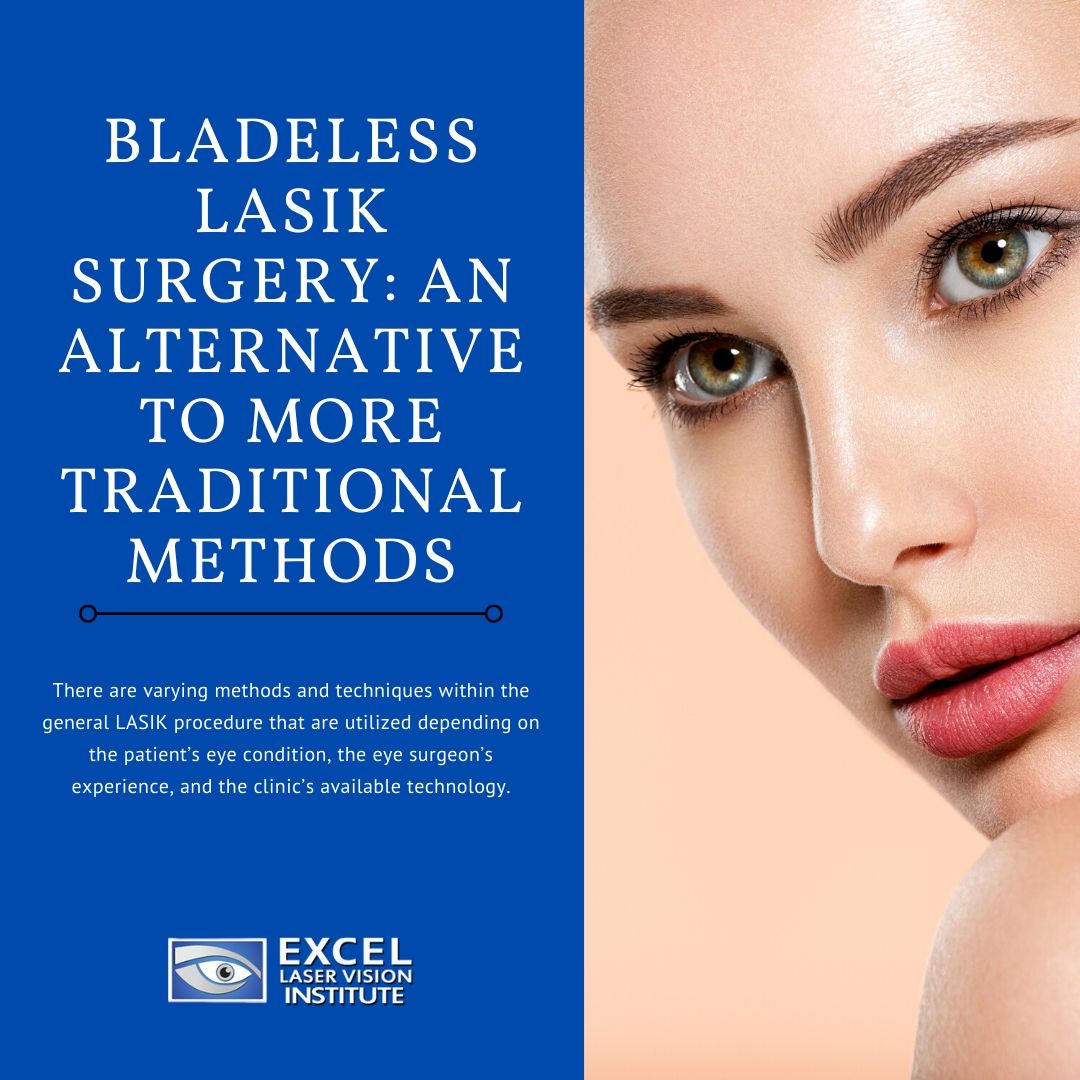
Bladeless LASIK Surgery, An Alternative to More Traditional Methods
Many people know that LASIK is a refractive surgery that utilizes laser technology to correct vision. However, not many people realize that LASIK has undergone some technical changes throughout the years in order to improve accuracy, safety, and reliability. The LASIK Los Angeles surgeon informs us that there are varying methods and techniques within the general LASIK procedure that are utilized depending on the patient’s eye condition, the eye surgeon’s experience, and the clinic’s available technology.
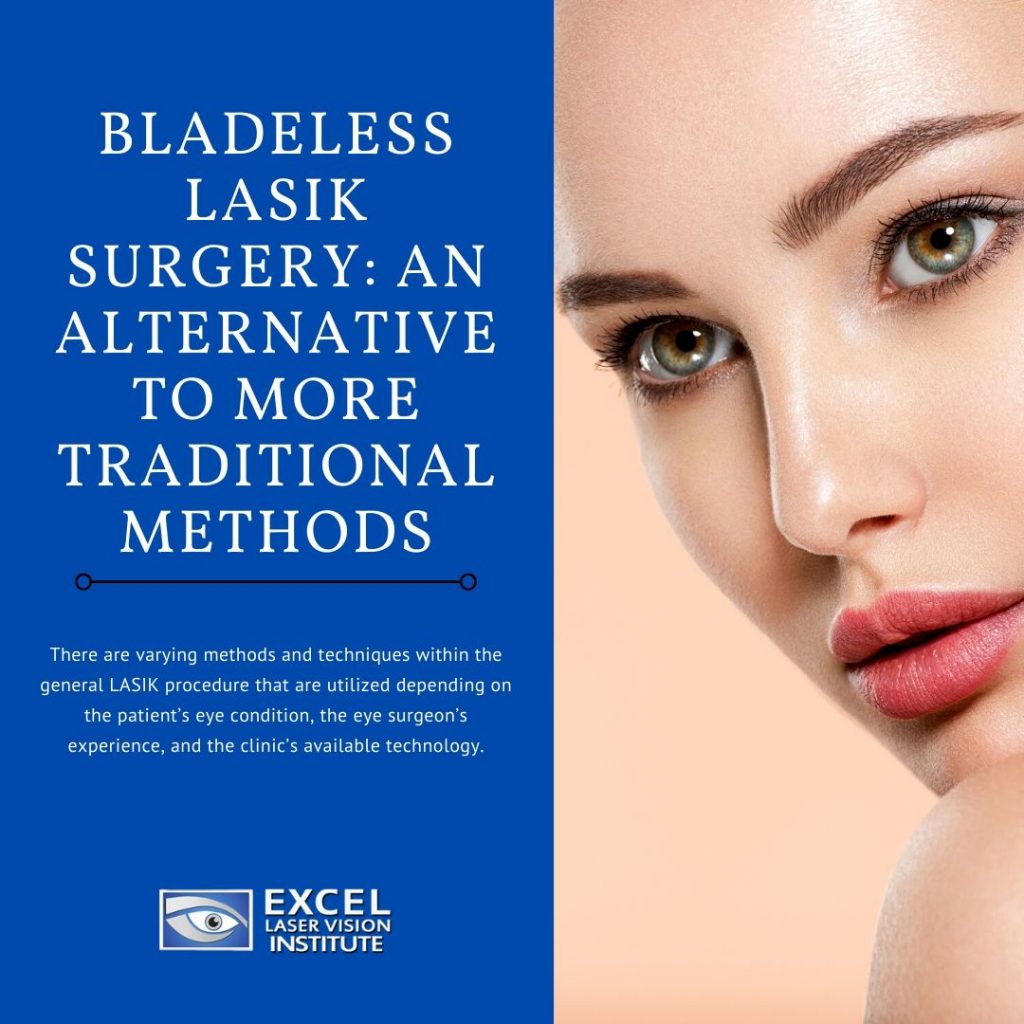
Not many people are aware of the more specific variation of the procedure called bladeless LASIK. This strategy is a more recent alternative to traditional methods that more and more surgeons are utilizing at the LASIK eye center in Los Angeles. According to these eye surgeons, bladeless LASIK is an alternative to the traditional LASIK procedure that has the potential to be more precise, customizable, and promote a faster healing time. In order to understand the distinction between bladeless and blade LASIK, this article will answer some commonly asked questions about the LASIK process and explain why bladeless LASIK is a good option for some patients.
What is the traditional LASIK process?
Laser In-Situ Keratomileusis, otherwise known as LASIK, is a surgical procedure that reshapes the cornea in order to allow light to better focus on the retina and, therefore, improve vision. Since the cornea is such an important aspect of optic functions, the ability to correct this can achieve unbelievable results for someone with nearsightedness, farsightedness, or astigmatism. The LASIK process has been around for over twenty years and used by eye surgeons to successfully achieve vision correction for patients around the world.
According to a LASIK Los Angeles surgeon, the traditional LASIK method includes two stages:
Stage 1: LASIK surgeons apply numbing drops to the patient’s eye in order to make the procedure more comfortable. Surgeons utilize a bladed instrument called a microkeratome to create a fine flap on the cornea. This opening is used to access the eye tissue underneath.
Stage 2: The LASIK surgeon utilizes an excimer laser to remove excess tissue and reshape the surface of the eye in order to achieve better vision. Once the surgery is complete, the corneal flap is replaced in order to ensure a smooth and quick recovery.
What makes bladeless LASIK different?
Bladeless LASIK differs from traditional LASIK methods particularly in the first stage of the process. Instead of using a bladed instrument to create the corneal flap, surgeons will utilize a femtosecond laser. This is why bladeless LASIK is sometimes called “all laser LASIK.” Every other part of the process is pretty much the same. You will sometimes hear bladeless LASIK also called Femto-LASIK, Femtosecond-Assisted LASIK, and blade-free LASIK.
What does the femtosecond laser do?
The femtosecond laser is a machine that utilizes far infrared waves to generate fast-moving energy that can be used to make microscopic incisions. This high-powered energy creates bubbles of carbon dioxide, water, and nitrogen within the cornea and, thus, decreases the temperature of the particles in the field. Since bladeless LASIK does not use heat to manipulate tissue, it is generally known as a non-thermal treatment. Corneal bubbles allow eye surgeons to keep track of the microscopic flap in LASIK surgery and find the desired area below, where correction takes place.
What does the excimer laser do?
The excimer laser is a computer-guided machine that helps surgeons create a customized strategy for reshaping a patient’s eye tissue. Customization depends on the patient’s individual eye condition. The laser works by utilizing far UV light to break chemical bonds within the eye. This technology allows surgeons to reshape the cornea without causing heat damage. Within the field, the excimer laser is known as the “cool” laser.
Why would bladeless LASIK be a better option?
Since bladeless LASIK uses a femtosecond laser instead of a bladed instrument to create the flap in the cornea, this process is inherently more precise. Many LASIK Los Angeles surgeons believe that bladeless LASIK provides a smoother operation which leads to more accurate vision correction and faster recovery. The femtosecond laser allows surgeons to control the thickness, diameter, and exact location of the flap as well as the properties of its hinge. With this improved ability to control the process, surgeons can further customize LASIK procedures to the needs of the patient.
Bladeless LASIK is generally a safe bet for patients that have thinner corneas, dry eye conditions, or high refractive errors. These patients might not qualify for traditional LASIK methods, which is why bladeless LASIK is such an important innovation in the practice.
Am I a good candidate for bladeless LASIK?
Bladeless LASIK has provided surgeons with the opportunity to offer more precise, safe, and comfortable laser eye surgery to patients around the world. This alternative has allowed people who could not qualify for regular LASIK to safely achieve vision correction through this innovative technology. Many surgeons are beginning to recommend this alternative to patients over traditional blade LASIK because of its track record for success. This newer, focused technology ensures a more accurate procedure and a quick healing time, making a happier patient.
While many more people qualify for a bladeless LASIK procedure, there are still limitations to who can receive this type of laser eye surgery. Patients who have received previous refractive surgery, had complications with traditional LASIK, or have corneal scarring may not be eligible for bladeless LASIK. The degree of your eye condition may also affect a surgeon’s recommendation. There are so many different types of laser eye surgery that can achieve the same goal: vision correction. In order to determine if you are a good candidate for bladeless LASIK, schedule an appointment with a LASIK specialist to have an eye examination and consultation. They will be able to evaluate your particular issues, whether it is nearsightedness, farsightedness, or astigmatism, and guide you to the right treatment.
If you want more information about LASIK surgery, do not hesitate to give Excel Laser Vision Institute a call at (818) 907-8606, or fill out our contact form today!
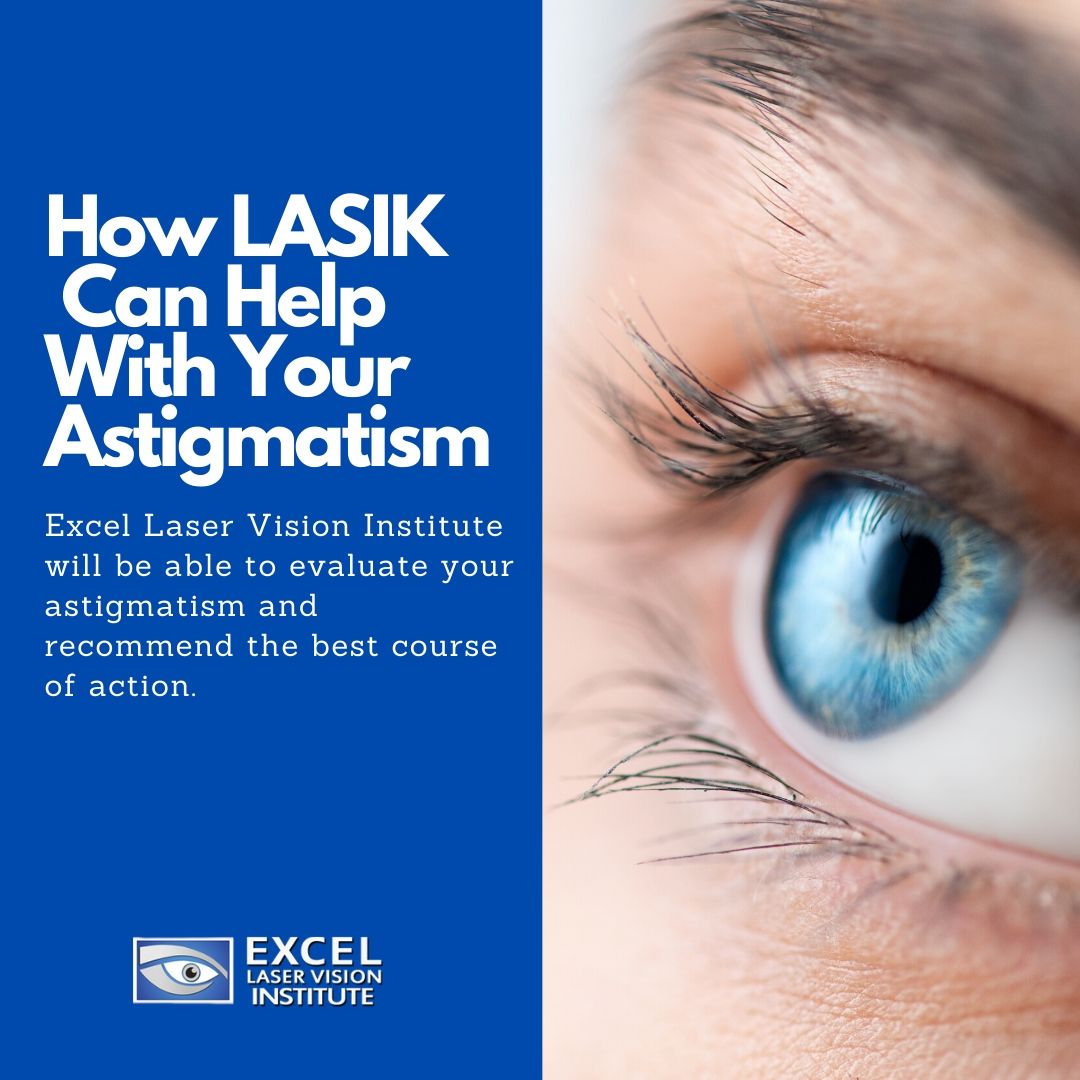
How LASIK Can Help With Your Astigmatism
Any eye doctor will tell you that astigmatism is a fairly common condition for people with vision problems. However, while a lot of people have it, not a lot of people fully understand what astigmatism means in terms of eye health and treatment. Fortunately, LASIK Los Angeles eye doctors will be able to evaluate your astigmatism and recommend the best course of action. Not many people realize that LASIK eye surgery can correct astigmatism as well as nearsighted and farsighted vision problems.
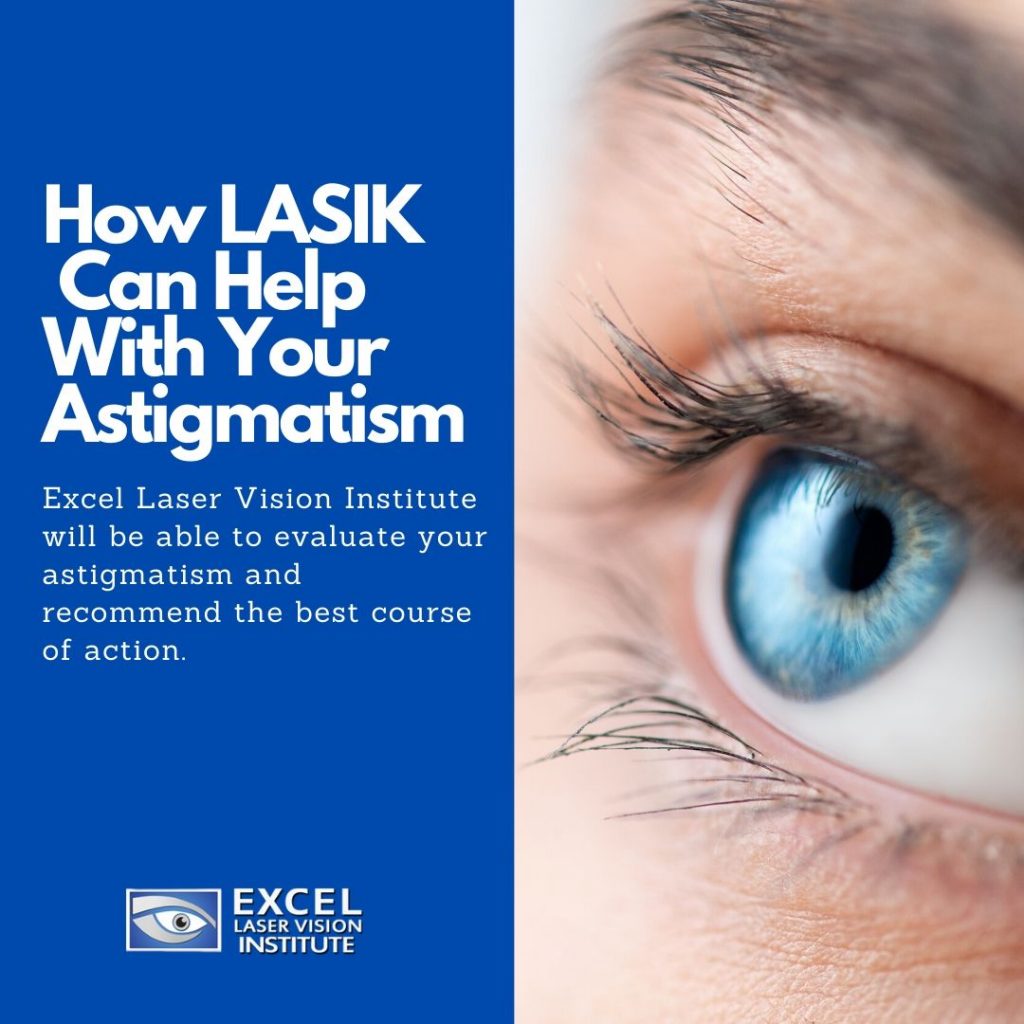
Astigmatism is a condition that occurs because of some imperfection in the eye’s curvature. This pressurized distortion can result in overall blurred vision. While the patient’s perception is the same either way, there are two different forms of astigmatism. The first kind, which is affected by an irregular-shaped cornea, is called corneal astigmatism. The second kind, which is affected by a distorted lens, is called lenticular astigmatism.
Research has shown that astigmatism can be connected to genetics, eye injuries, or keratoconus disease. Otherwise, medical experts are not always able to pinpoint the exact reason for the condition. Patients that visit the LASIK eye center in Los Angeles often have astigmatism along with nearsightedness or farsightedness. There are even some cases in which people have astigmatism without knowing it. Blurry symptoms can be downplayed, or completely absent, depending on the severity of the distortion and the age of the patient.
Eye doctors can diagnose astigmatism through numerous eye examinations that vary in intensity. Exams can range from a basic letter chart to a letter chart through an optical refractor to a keratometer test to an IOLMaster. All of these will help the eye doctor determine the shape of your cornea and whether or not this is affecting your vision. Doctors can also use computer-guided topography to map out the exact points of your eye.
Many people with astigmatism, especially the more subtle kind, will be given prescription lenses to correct the issue. However, glasses and contacts are not the only way of combating blurry symptoms related to astigmatism. Laser eye surgery at LASIK Los Angeles clinic like Excel Laser Vision Institute is another solution that many patients are starting to find very convenient for their vision correction.
Eye surgeons have been performing LASIK to successfully correct astigmatism for over 25 years. The advantage of this procedure is that it frees a patient from having to wear their glasses or contacts and provides a more permanent solution for their vision issues. Many patients that have undergone LASIK surgery describe the process as fast, easy, and pain-free.
LASIK has not always been a solution for astigmatism, which is why a lot of people are still unaware of this available treatment option. At the time that LASIK was approved by the FDA, methods for correcting astigmatism were not perfected and thus could not be officially authorized. However, the advance of laser technology has created the opportunity for surgeons to achieve more accuracy than ever before.
The latest technology at LASIK Los Angeles clinics allows for eye surgeons to fix astigmatism even better than a prescription lens. LASIK methods can erase the eye distortion entirely instead of merely contradicting it to maintain balance.
If you are thinking about getting LASIK to correct your astigmatism, you may be wondering about the price range of this procedure. The truth of the matter is that LASIK prices depend on many different factors like region, clinic, doctor, technology, and eye condition.
The more complicated your condition is, the more expensive your procedure is going to be. Doctors who take a more customized approach will utilize high-quality lasers that map out the procedure according to your individual circumstances and needs. More in-demand clinics and surgeons will also charge a little more for their services because they have a better record of success. Fortunately, there are some financing options for patients that decide that LASIK is their best option.
Beware of LASIK prices that are too cheap, as that could be an indication that the clinic is not responsible for their patients. In order to assess the quality of a LASIK offering, you should do your research on the clinic and doctor. Ask for references and look up reviews online in order to see what other people’s experiences with that clinic or surgeon have been in the past. Here are some helpful questions that you can ask the LASIK clinic in order to ensure that you are paying for quality care:
- What does the cost cover in terms of the procedure?
- What does the cost cover in terms of pre-surgery and post-surgery care?
- Am I allowed any financing options? Do these acquire any interest?
- How new are your laser machines? How often do you update this technology?
- Will I be offered any post-surgery treatment or prescriptions?
- What kind of prescriptions will be necessary for my recovery and what kind are optional?
- Will I be needing contacts or glasses, even temporarily, after my procedure?
- How many patients have you helped with astigmatism through a LASIK procedure?
- What is the training record and experience of the surgeon?
- How much time do you spend consulting each patient?
Many eye doctors and previous LASIK patients will say that LASIK is an investment. While it can be an expensive procedure, it is often much more expensive to continue dealing with eye issues without the freedom and permanence of laser vision correction. Your time and energy is just as valuable as the money you spend on glasses and contacts every year. LASIK can eliminate the need for prescription lens costs and free up your time for more important things. The procedure only takes about 15 minutes altogether and the recovery time is very quick.
If you have astigmatism and are considering LASIK as a solution, schedule an appointment at a clinic that performs LASIK and get a full examination. The doctor will be able to fully evaluate your condition and determine the extent that LASIK surgery will help with it. Not everyone is a qualified LASIK candidate, which is also why it is important to get this eye examination before weighing your options.
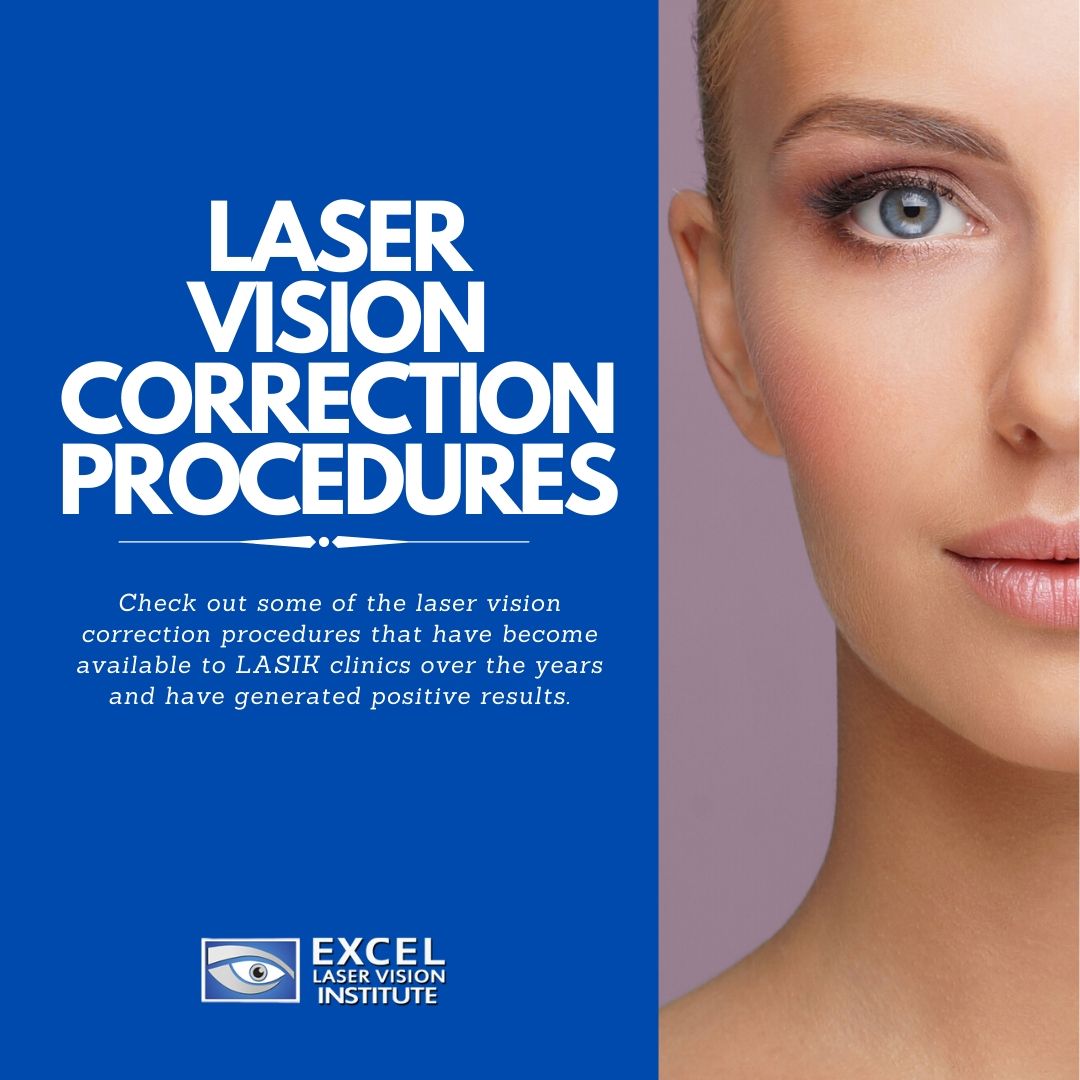
Laser Surgery Choices
Many people have heard of LASIK eye surgery as an option for vision correction because it is so widespread. However, most people do not realize that there are other successful laser correction procedures that clinics will perform as an alternative. LASIK Los Angeles clinics like Excel Laser Vision Institute offers an array of procedure choices that differ slightly in method but achieve the same goal: better vision for the patient. The advantage of having access to different laser machines and surgery techniques allows surgeons at the LASIK eye center Los Angeles to customize treatments to each individual.
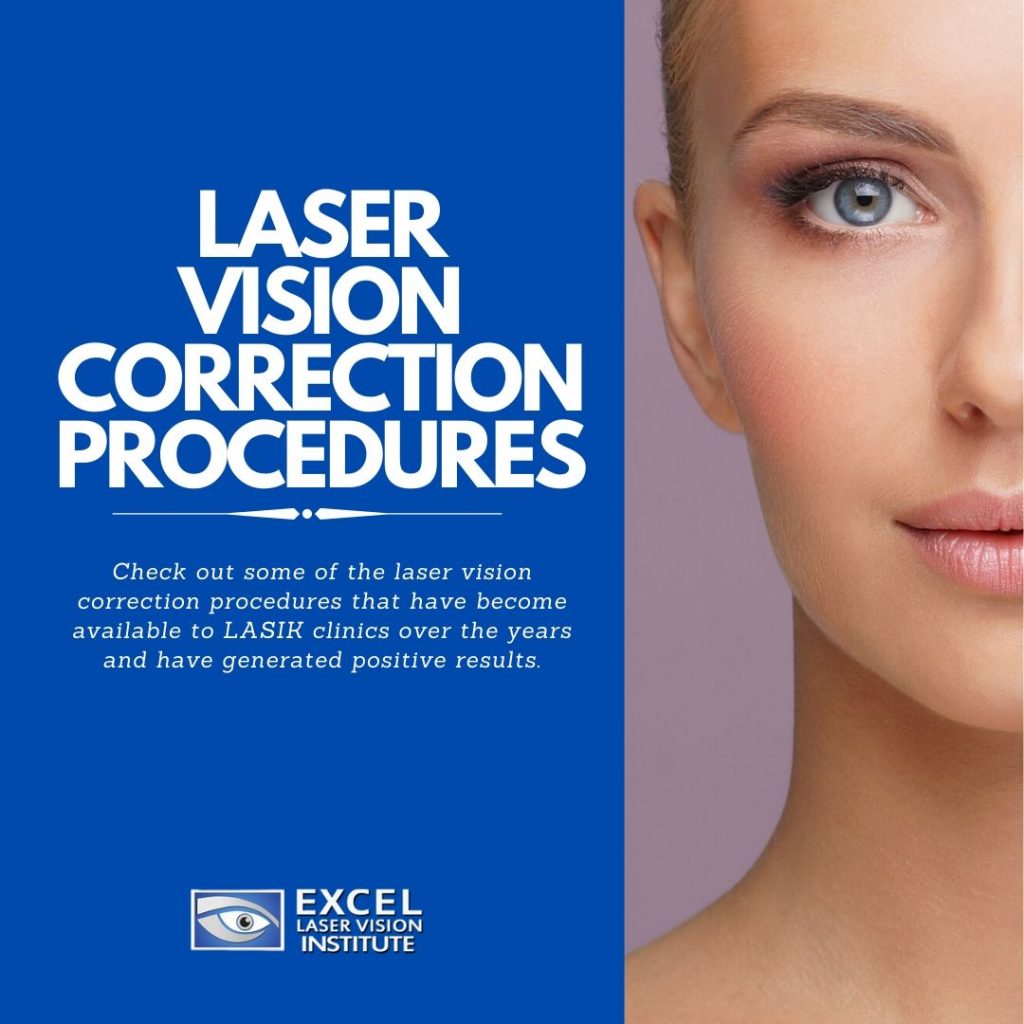
In this article, we will outline some of the laser vision correction procedures that have become available to LASIK clinics over the years and have generated the same positive results.
Laser In Situ Keratomileusis (LASIK)
As a lot of people know, LASIK is a type of refractive surgery that is used to correct vision by manipulating the shape of the cornea. This adjustment allows light to pass through the eye and accurately focus, stimulating better vision.
LASIK surgery is performed by using a femtosecond or microkeratome laser to cut a thin flap in the cornea in order to access the part of the eye that is promoting vision impairment. An excimer laser is then used to remove excess tissue and the corneal flap is replaced. Each eye can take less than 10 minutes. LASIK surgeons will use anesthesia drops to ensure little to no discomfort for the patient during the procedure. Results can be seen in less than 24 hours.
For many years, LASIK eye surgery has been the go-to laser vision correction option. It has been mentioned in over 7,000 peer-reviewed scientific articles that champion its safe and accurate results. In a series of studies that were publicized from 2008 to 2015, researchers reported many statistics that were favorable to the procedure:
- 98.8% of LASIK patients were pleased with their surgery outcome
- 99.5% of LASIK patients gained 20/40 vision or better after the surgery
- 98.6% of LASIK patients measured within 1.0 diopters of their vision goal
- 90.9% of LASIK patients measured within 0.5 diopters of their vision goal
LASIK Los Angeles surgeons explain that LASIK eye surgery is often recommended for patients that are nearsighted, farsighted, or have astigmatism. LASIK candidates also require a certain corneal width in order to qualify for the surgery.
Photorefractive Keratectomy (PRK)
While not many people have heard of PRK, this eye correction procedure has been used for over 20 years and has proven similar results to LASIK. Researchers find PRK comparable to LASIK in safety and accuracy. However, the differences lie in method and recovery. PRK patients often have a longer recovery period due to the nature of the procedure.
Similar to LASIK, surgeons performing PRK will utilize anesthesia drops to soothe any irritation that might arise from the procedure. The process begins by peeling off the epithelium layer of the cornea and then utilizing an excimer laser to extract excess tissue that is causing vision impairment. After this correction, the surgeon will add a contact lens as protection for the healing eye. LASIK Los Angeles surgeons say that it takes around 5 days for the epithelium to grow back.
Surgeons will often prescribe eye drops for post-surgery care in order to avoid infections, dry eye, and inflammation.
While PRK can require a longer period of adjustment after the surgery, this procedure is sometimes necessary as an alternative to LASIK for patients with certain eye conditions. Patients with thinner corneas, scarring on their cornea, or larger pupils could benefit from PRK when they do not qualify for LASIK surgery. Surgeons will also recommend PRK to candidates who engage in contact sports or maintain a riskier job with the potential for eye injury.
Small Incision Lenticule Extraction (SMILE)
The most recent innovations in laser vision correction have led to widespread acceptance of the SMILE method. In this procedure, surgeons utilize a femtosecond laser to make a half-moon shape of tissue within the cornea. Then, this tissue is removed from an incision by the laser. This process adjusts the shape of the cornea in order to enhance vision while avoiding all other areas of the eye.
Since the opening created by the laser is so microscopic, this procedure is generally thought of as less invasive than other eye correction surgeries. Over 1.5 million SMILE surgeries have been performed around the world and it has been widely used for over 10 years.
SMILE is particularly useful as an alternative to LASIK for patients with nearsighted issues. Studies show that SMILE can achieve the same vision enhancement results for this impairment. Over 400 clinical trials have proven SMILE as an accurate and safe alternative for qualifying candidates. Research statistics have found that:
- 99% of SMILE patients gained 20/40 vision or better 6 months after the surgery
- 84% of SMILE patients gained 20/20 vision or better 6 months after the surgery
- 91.7% of SMILE patients were pleased with their surgery outcome
Like LASIK and PRK, the SMILE procedure can take about 10 minutes or less per eye. This method is particularly recommended for nearsighted patients that want a minimally invasive surgery with a lower risk for complications. Patients that are nearsighted and also have astigmatism may be a good candidate for SMILE as well.
Now that more and more people are seeking laser vision correction, it is important for everyone to understand the options that are available to them. While LASIK is a proven method that is appropriate for many patients, there are other successful procedures that achieve the same results with a slightly different set of tools and techniques. When consulting an eye surgeon, be sure to ask them about PRK and SMILE to see if you are perhaps a better candidate for these alternative eye surgeries. Your surgeon will consider your eye conditions and your lifestyle in their recommendation for your treatment and they will explain in greater detail why they think one method would be better for your individual vision goals.
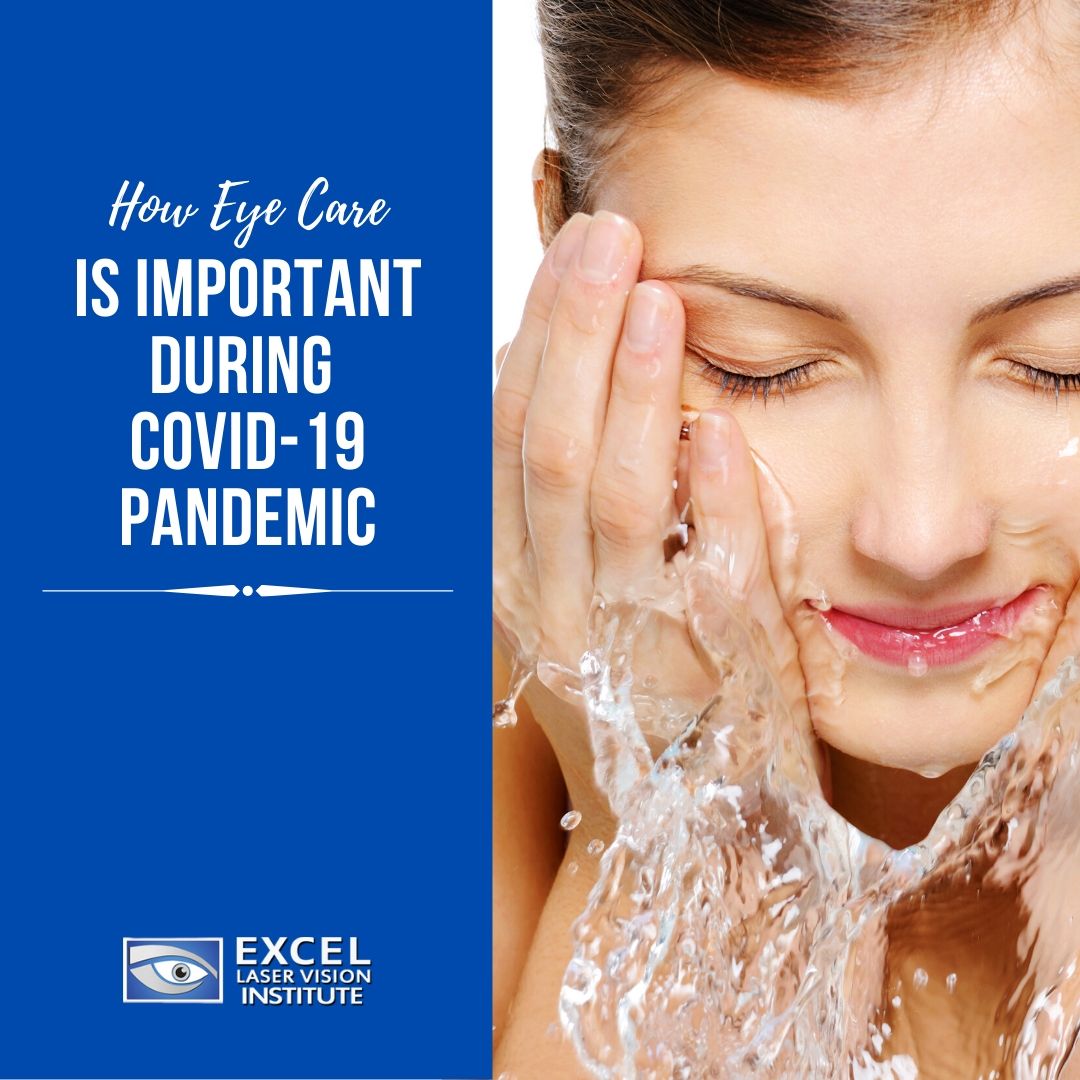
How Eye Care is Important During COVID-19 Pandemic
Since the world was hit with COVID-19, many people are trying to collect as much information as they can to prevent themselves and loved ones from getting sick. Doctors are telling everyone to refrain from touching their mouth, nose, and eyes in order to prevent the spread of respiratory droplets that contain the virus. According to a LASIK surgeon in Orange County, the mucous membranes in the body are particularly vulnerable to the coronavirus.
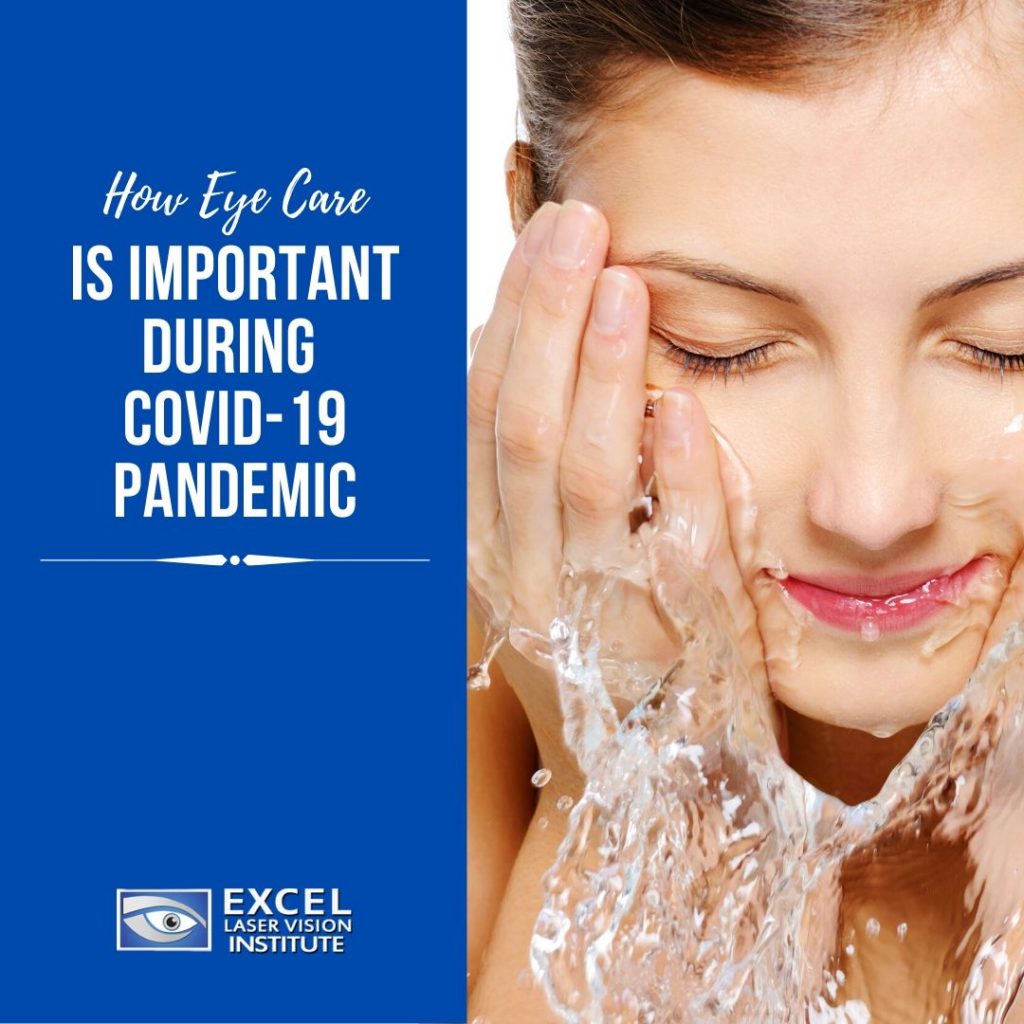
The CDC (Centers for Disease Control and Prevention) is advising everyone in the United States to put on cloth masks when going out. This precaution is something that doctors at LASIK Orange County clinics have agreed is necessary to slow the rate of infection. However, most face masks do not protect the eyes, which are just as susceptible to contracting infections.
In one case, Wang Guangfa, a Peking University doctor, contracted the virus while treating patients in China. Some say his exposure was due to a lack of eye protection. This doctor first experienced inflammation in his left eye and then a fever followed by mucus buildup in his throat and nose. According to a professor of medicine and pathology at UT Health San Antonio, this unfortunate circumstance could have possibly been caused by infected droplets coming into contact with Dr. Wang’s eyes. Although, there is still much to learn about the way that COVID-19 operates as a disease.
If you consult a LASIK surgeon in Orange County, they will tell you that you can minimize eye exposure by wearing glasses. People who wear contacts on a regular basis should switch to corrective lenses in order to avoid the constant finger-eye contact that comes with inserting and removing contacts.
While some people will not want to give up their contacts for convenience’s sake, it is generally found that people who wear glasses touch their eyes less than people who wear contacts. Even those who are extremely diligent with handwashing and contact cleansing should consider dropping their normal routine for extra precaution. According to a LASIK surgeon in Orange County, glasses can also offer a sort of a protective shield from respiratory droplets traveling in the air. Safety goggles are an even better option.
There are some COVID-19 patients that experience ocular symptoms like pink eye. Pink eye, or conjunctivitis, is the condition where the membrane around the eyeball is inflamed. This produces a red, itchy, teary eye. Doctors have seen conjunctivitis along with other respiratory infections such as flu and colds, which is why they are starting to wonder if it has symptomatic connections to the coronavirus. Current research on this correlation in China has found only a 0.8% likelihood of contracting pink eye along with COVID-19. So, while some cases may experience this connection, it is not very probable.
In order to properly face COVID-19, it is important that everyone is on the same page with information. This will allow individuals to adequately take preventative measures for themselves and others around them.
So, what are the important facts to know about COVID-19? The virus appeared first in Wuhan, China in December of 2019. The coronavirus can produce cold-like symptoms like coughing and sneezing in less serious cases. On the other hand, more major infections can lead to pneumonia, bronchitis, kidney failure, and even death.
Doctors understand that COVID-19 can be spread in crowd-like environments and other public spaces. This is why many public offices, restaurants, stores, and parks have been closed for the moment and many community events have been rescheduled or canceled. Medical experts are still trying to assess the level of contagiousness and the factors that may make someone more predisposed to contract the virus.
In the meantime, it is best for all individuals (whether showing symptoms or not) to avoid public gathering places. Social distancing is the new term that medical experts and concerned citizens are using to describe the practice of limiting exposure. Now, many places in the United States have enacted a shelter-in-place policy to encourage people to work from their homes as long as they are not an “essential worker.”
It is important for everyone to reduce exposure as much as they can as well as understand and detect symptoms as early as possible. Here are some symptoms to look out for:
- Fever
- Cough
- Difficulty breathing
- Runny nose
- Sore throat
- Headaches
- Loss of taste or smell
- Red eyes
Symptoms can range from mild to moderate to severe, depending on the age and health of the patient. Most people experience symptoms between 2 and 14 days of exposure.
Now, that you understand COVID-19 a little bit better, here are some helpful tips to reduce exposure and stay safe:
- Wash your hands thoroughly and often. Medical experts suggest that people take 20 seconds to wash hands with soap and water before and after eating, using the restroom, coughing, sneezing, or blowing their nose. This habit will help those who find it difficult to refrain from touching their face.
- Avoid touching nose, eyes, and mouth. This is the obvious recommendation. However, it is especially important when hands have not been recently cleaned.
- Limit exposure. This includes working from home, ordering food to be delivered when possible, and avoiding public spaces.
- Be aware when you’re coughing and sneezing. If you have to cough or sneeze, use your arm or tissue to protect others from infection. ]
- Disinfect surfaces. Even when you’re in the safety of your own home, you should make an effort to clean your spaces. This is not only for your protection but also for the protection of those you live with. The CDC states that items, once exposed with COVID-19, can retain the virus for up to a few days, depending on the material. On cardboard, it is thought to have a 24-hour lifespan and on plastic and stainless steel, it may last 3 days.
- Wear a mask if you are sick or caring for someone who is sick. In other cases, it is best to make do with homemade cloth masks. Medical grade masks should be saved for those who need it. If you are taking care of someone who is sick, you should get a hold of safety goggles, medical masks, protective gloves, and wear attire that covers your skin.
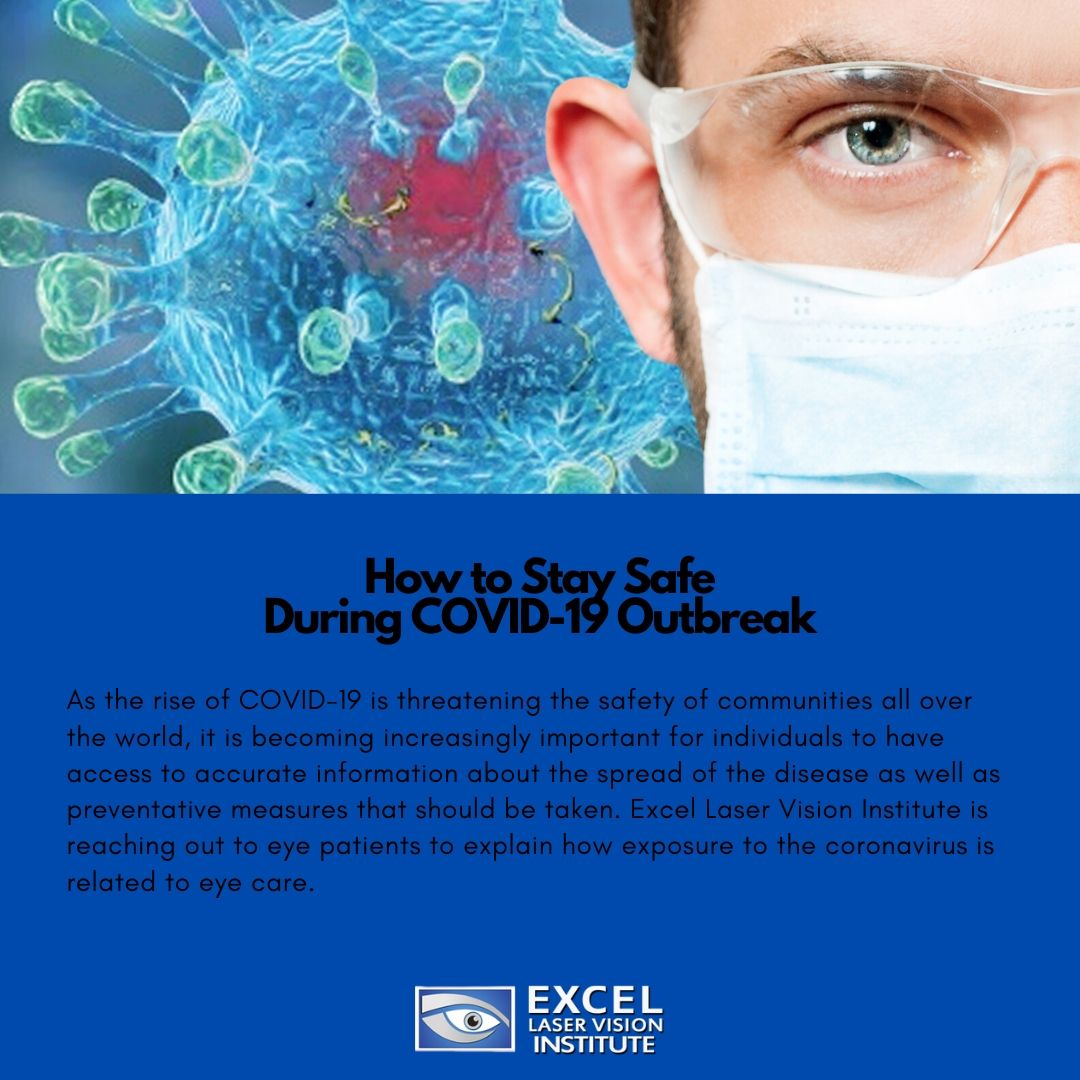
How to Stay Safe During COVID-19 Outbreak
As the rise of COVID-19 is threatening the safety of communities all over the world, it is becoming increasingly important for individuals to have access to accurate information about the spread of the disease as well as preventative measures that should be taken. LASIK Los Angeles clinics, specifically Excel Laser Vision Institute, are reaching out to eye patients to explain how exposure to the coronavirus is related to eye care.
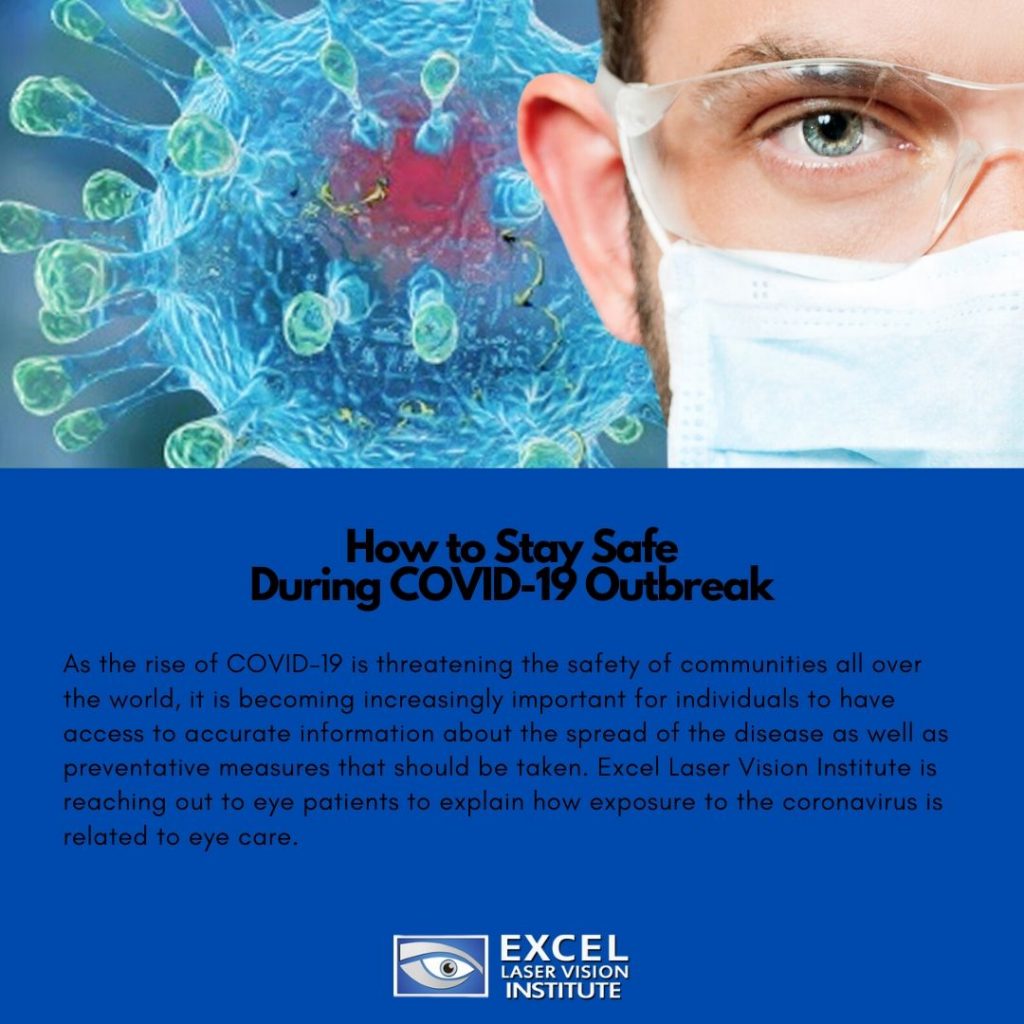
COVID-19 is a respiratory disease that can be contracted through the eyes as well as the nose, mouth, ears, etc. The most common symptoms of the disease include fever, cough, and difficulty breathing. These symptoms usually appear between 2 and 14 days after a person has contracted the illness. People with the virus can develop serious infections, contract pneumonia and, in the worst cases, even die. This is why the LASIK eye center in Los Angeles like Excel Laser Vision Institute says it is important to remain vigilant and minimize all avenues of exposure.
Someone who has the coronavirus can spread it to other people through leaving trails of microscopic particles that contain the virus. This can happen when the person coughs or wipes their nose and then touches a surface that someone else may come into contact with. Many doctors are advising people to avoid touching their face and cleaning surfaces often in order to avoid these pesky infected particles. LASIK Los Angeles clinics are telling their patients that COVID-19 can be spread through eye fluid, which is why it is so important to practice safe eye care during this outbreak.
In order to slow the rate of infection, many clinics are limiting the amount of patients that can come in for appointments. With more restrictive policies, clinics are able to minimize doctor-patient contact and thus reduce the risk of exposure. In addition to this, clinics are trying to preserve necessary medical tools like masks and face shields in case of emergencies. Most in-person appointments are being rescheduled for a later date in order to follow safety recommendations.
Many eye doctors will still be available through phone consultations so, if you are experiencing any serious symptoms, please call for professional advice:
- Sudden changes in vision (blurry, blank spots, or waviness)
- More floaters than usual and flashes of light
- Loss of vision
- Red eye, pain, headaches, nausea, and vomiting
If you require regular injections for diabetic retinopathy, macular degeneration, or any other eye condition, speak to your eye doctor about changes to your appointment routine. In the case where you absolutely must visit a clinic, please practice social distancing. Many clinics will likely have new requirements to limit the risk of exposure. Here are some of the ways in which your in-person visit may be different in the time of COVID-19:
- You may not be allowed to sit in a waiting room. Some clinics are having patients wait in their car and be summoned by phone instead of sitting close to strangers. Other clinics have lines set up outside with lines of tape (6 feet apart) where patients can wait.
- You may need to go to your appointment alone. Many clinics are trying to limit the amount of people in the office. So, if you do not require someone to help you with your appointment, then it is best to go alone.
- Your eye doctor may look different. Clinics are trying to best prepare their doctors for the risk of interacting with patients by requiring more protective gear. You may see your doctor using a new face shield or mask to protect their face.
- You may have a quieter appointment. Some doctors are asking their patients to refrain from opening their mouths until the examination is finished. Then, they will allow for questions. This is to ensure that doctors are not exposed to patients while up close in examinations.
In-person appointments should be avoided, especially if you are exhibiting signs of COVID-19. Thankfully, many clinics have set up successful virtual appointments where patients can consult their doctor over the phone and video chat.
While COVID-19 is a new disease that scientists, researchers, and medical professionals are still trying to understand, there are some definite ways that people can protect themselves. Here are some recommendations from LASIK Los Angeles clinics particularly Excel Laser Vision Institute:
- Avoid contacts and wear glasses instead. People who wear contact lenses on a regular basis know that this method of vision correction requires a lot of finger-eye contact. It is best to avoid touching one’s eyes in order to limit the amount of virus exposure. Wearing glasses will allow people to achieve their desired vision without the risk of eye contact.
- Glasses can be used as a sort of eye shield. Even for those who do not necessarily need corrective lenses, glasses can be used as a way to block the coronavirus particles from entering your eye. Like wearing safety goggles, this is just one way to minimize exposure.
- Try to obtain your prescriptions in advance. For those who require regular eye medication or drops, it is important to keep a healthy supply in the case of quarantine. There are also some methods of prescription delivery that may be available depending on your insurance.
- Do not rub your eyes. It can be tempting to do this, especially when you are told not to, but it is important to follow this rule in the case of a pandemic. When feeling an itch, try to use a clean tissue instead of your hand. If you absolutely have to use your fingers, then make sure to wash your hands for 20 seconds before and after.
- Follow good hygiene practices. This includes thoroughly washing your hands with soap and water for 20 seconds every time you come into contact with new, unclean surfaces or environments. You should always clean your hands after sneezing, coughing, blowing your nose, using the restroom, and before eating. In the case where you do not have soap and water available, carry around a sanitizer with 60% alcohol. Good hygiene also includes not touching your face, covering your coughs and sneezes with an arm or tissue, avoiding sick people, staying home, and disinfecting everyday surfaces and objects that you use.
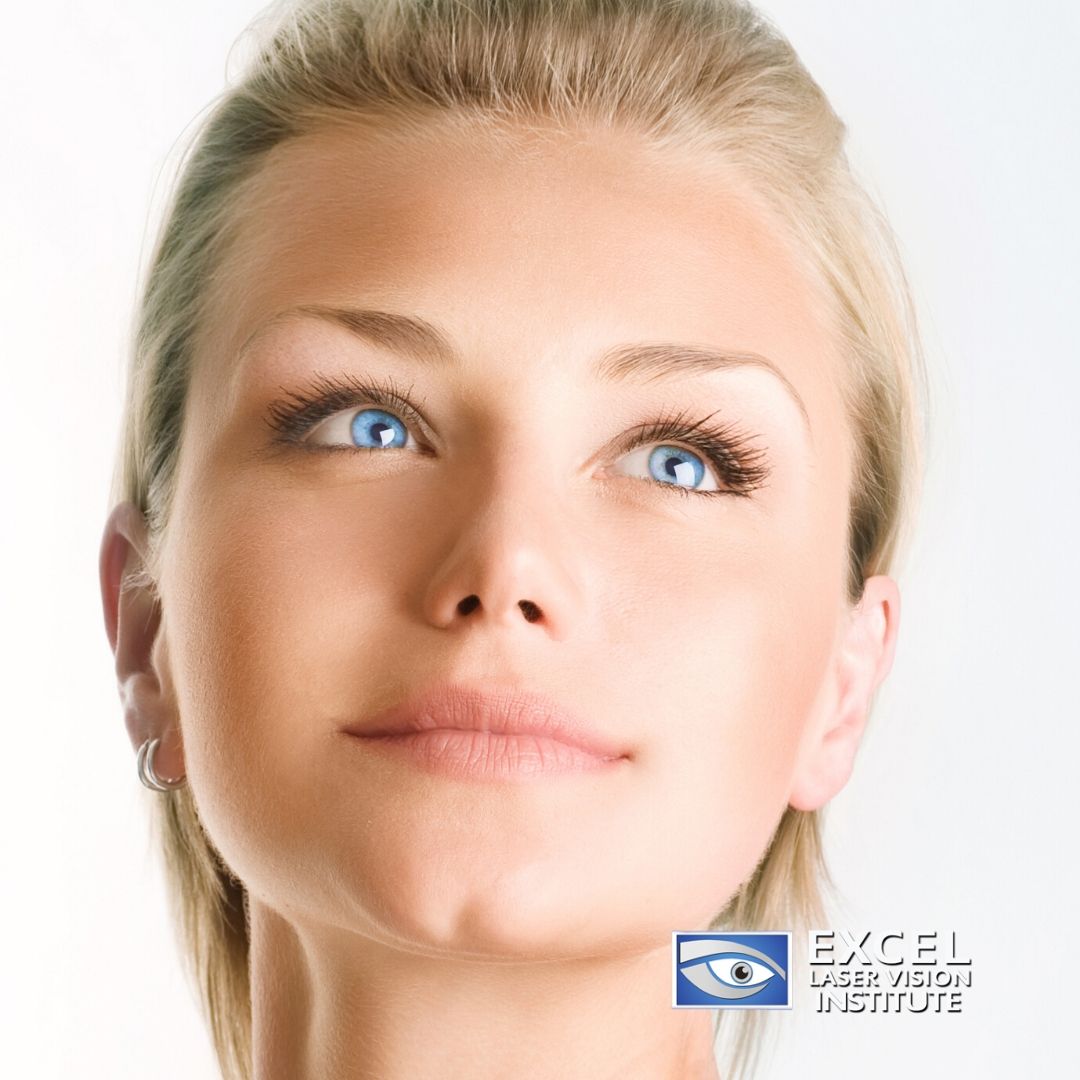
Do You Qualify For Laser Eye Surgery?
Many people know how expensive it can be to wear glasses. Fashionable lenses come and go, causing people to desire the latest trends that will match their wardrobe. Other people wear their frames out from regular use, leaving them desperate for new frames every year. Some people even start to lose their glasses, which induces them to buy a new pair every now and then. The LASIK surgeon in Orange County understands all the hassles and extra costs that make people consider other vision correction options that are available to them.
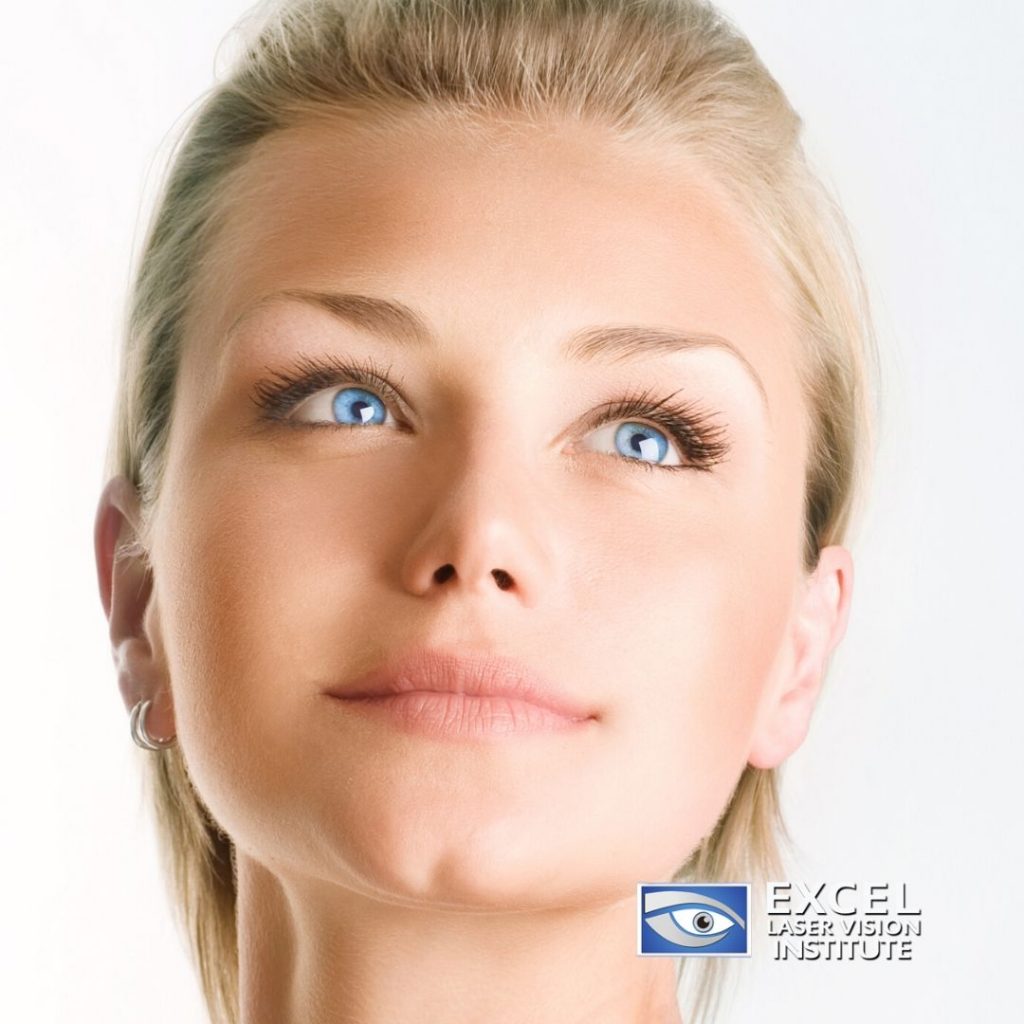
Some LASIK Orange County patients will ditch their specs completely and try less conspicuous eye correction methods such as contact lenses. However, as the LASIK surgeon Orange County explains, these are not designed to be a permanent eye correction solution and could even worsen issues when they are worn for too long or too regularly.
Do I Qualify For LASIK?
Before you spend good money on a pair of new eyeglasses or contacts, it is a good idea to weigh your available options. The LASIK surgeon Orange County says that the best way to know whether you are a good candidate for LASIK is to have a thorough examination by a board-certified ophthalmologist, such as Dr. Ferzaad Moosa, who specializes in corneal laser refractive surgery. A highly trained eye surgeon like Dr. Moosa can let you know if your prescription is treatable.
Nevertheless, your prescription is just one aspect of qualifying for LASIK. There are many other points of criteria that a patient has to meet to get the go-ahead from their eye doctor.
Listed below are the five factors that are essential to becoming a qualified candidate for LASIK surgery.
Is Your Prescription Within A Treatable Range?
The first thing your eye doctor will want to know is the prescription of your glasses since it is one of the best indicators to see if someone is suitable for a LASIK procedure. An individual’s prescription sometimes referred to as “refractive error,” is measured in diopters. Eye doctors use a diopter as a metric unit to indicate the strength of the lens that is required to correct a person’s vision. In fact, on your prescription card, you will see numbers that are in diopters. When there is a minus next to the numbers, it signifies near-sightedness and the plus sign represents far-sightedness.
Normally, eye surgeons can use the most state-of-the-art lasers and screening tools to treat up to +6.00 of farsightedness or hyperopia, up to -12.00 of near-sightedness, and up to 6 diopters of astigmatism. However, these exact numbers depend on the clinic, the technology, the expertise, and the type of treatment they have available.
Is Your Prescription Stable And Are Your Eyes Healthy?
You will know that you have a stable prescription when the numbers on your prescription card remain the same for at least two uninterrupted years. This is one of the reasons that, even though LASIK is approved for anyone who is 18 years or older, many eye doctors advise their patients to wait to have LASIK until they are in their mid-twenties.
When you are around this age, you have reached “ocular maturity” which means that a person’s prescription is not likely to change for a while. However, age is not the only factor that plays a role in having a stable prescription. The other circumstances that may affect a person’s prescription are general health, medication use, and pregnancy. Fortunately, many of these circumstances are temporary and won’t completely disqualify a person from receiving treatment.
What Is the Shape And Thickness Of Your Corneas?
LASIK is very different from eyeglasses and contact lenses since it is a permanent vision correction method that works by reshaping the cornea. The eye’s cornea is the transparent dome-like surface that helps the eye to focus light to create an image on the retina.
If your cornea is too thin or misshapen, it may cause issues with your vision. Typically, a LASIK evaluation at Excel laser Vision Insitute can help to evaluate the thickness and shape of the cornea, and whether it is safe to go ahead with the treatment.
What Is The Size Of Your Pupil?
During your LASIK consultation, your eye surgeon will most likely want to know the size of your pupil. If you have naturally large pupils, for example, you might have a higher risk of experiencing side effects following LASIK surgery, such as glare or halos at night. However, this cannot necessarily be determined by just looking at your pupils in the mirror so you should still seek the advice of a LASIK surgeon. Not everybody with large pupils is excluded from having LASIK, especially at clinics with advanced technology.
Do You Have Any Eye Conditions?
Existing conditions such as dry eye can sometimes worsen with LASIK surgery and should be considered before going ahead with the procedure. LASIK evaluations will check that you are able to look continually at a fixed spot or object for at least a minute. This will enable the eye surgeon to perform LASIK correctly.
If you have certain eye conditions such as glaucoma or cataracts, as well as any other type of eye infection or injury, this can interfere with LASIK surgery. Communicate these conditions with your eye surgeon so that he or she can carefully consider them before going ahead with your eye surgery.
There are also many other procedures besides LASIK that can be used to fix common vision problems. A well-trained eye refractive surgeon such as Dr. Ferzaad Moosa at the Excel Laser Vision Institute can help you decide on the best option for your vision goals. If you have any more questions about LASIK eye correction procedures, give the Excel Laser Vision Institute a call at + (818) 907-8606 to arrange an appointment today.

